TP Link Technologies C3150 AC3150 Wireless MU-MIMO Gigabit Router User Manual Part 3
TP-Link Technologies Co., Ltd. AC3150 Wireless MU-MIMO Gigabit Router Users Manual Part 3
Contents
- 1. Users Manual Part 1
- 2. Users Manual Part 2
- 3. Users Manual Part 3
Users Manual Part 3
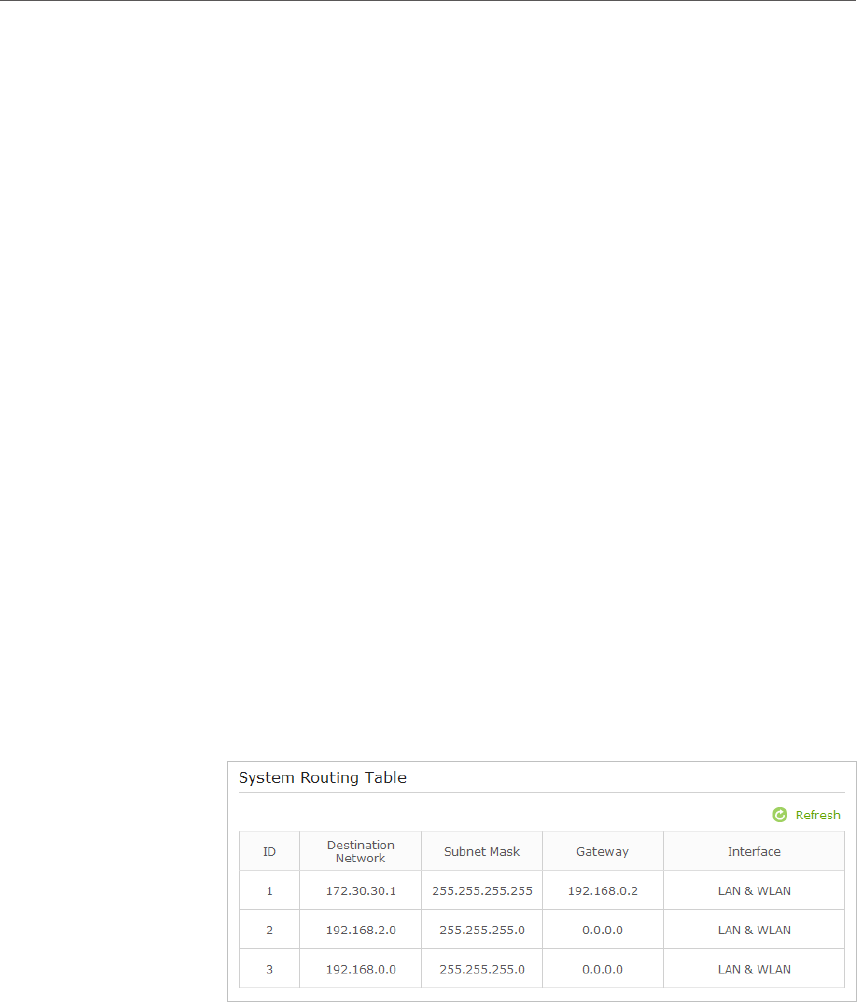
77
Chapter 12 Customize Your Network Settings
the IP address of the company network is the destination IP
address, so here enters 172.30.30.1.
Subnet Mask: Determines the destination network with the
destination IP address. If the destination is a single IP address,
enter 255.255.255.255; otherwise, enter the subnet mask of
the corresponding network IP. In the example, the destination
network is a single IP, so here enters 255.255.255.255.
Gateway: The IP address of the gateway device to which the data
packets will be sent. This IP address must be on the same subnet
with the router’s IP which sends out the data. In the example, the
data packets will be sent to the LAN port of Router 2 and then to
the Server, so the default gateway should be 192.168.0.2.
Interface: Determined by the port (WAN/LAN) that sends out
the data packets. In the example, the data is sent to the gateway
through the LAN port, so LAN should be selected.
Status: Determines the status of the entry. In the example,
Enabled should be selected.
6. Click OK to save the settings.
7. Check the System Routing Table below. If you can find the
entry you set, the static routing is set successfully.
Open a web browser on your PC. Enter the company server’s IP
address to visit the company network.
12. 6. Specify Wireless Settings
The router’s wireless network names (SSIDs) and passwords, and security options are
preset in the factory. The preset SSIDs and passwords can be found on the product
label. You can customize the wireless settings according to your needs.
1. Visit http://tplinkwifi.net, and log in with the username and password you set for the
router.
Done!
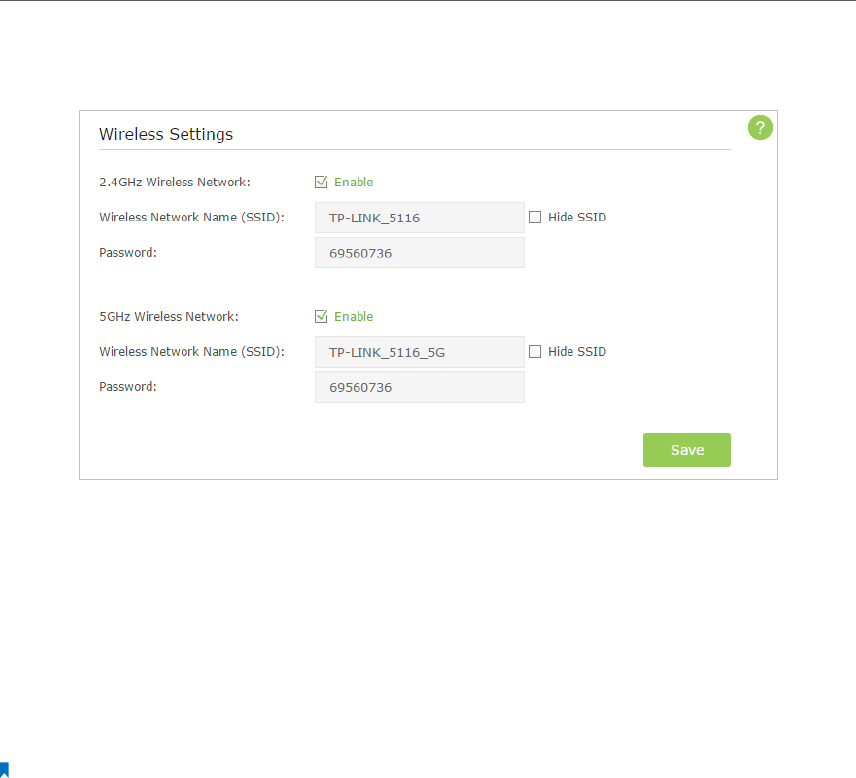
78
Chapter 12 Customize Your Network Settings
2. Go to Basic > Wireless.
To enable or disable the wireless function:
The wireless radio is enabled by default, if you want to disable the 2.4GHz, 5GHz wireless
function, just clear the corresponding Enable checkbox.
To change the wireless network name (SSID) and wireless password:
Create a new SSID in Wireless Network Name (SSID) and customize the password for the
network in Password. The default SSID is TP-LINK_XXXX for 2.4GHz, TP-LINK_XXXX_5G
for 5GHz, and the value is case-sensitive.
Note:
If you use a wireless device to change the wireless settings, you will be disconnected when the settings are effective.
Please write down the new SSID and password for future use.
To hide SSID:
Select Hide SSID, and your SSID will not broadcast. Your SSID won’t display when you
scan for local wireless network list on your wireless device and you need to manually
join the network.
Advanced Settings:
Go to Advanced > Wireless >Wireless Settings.
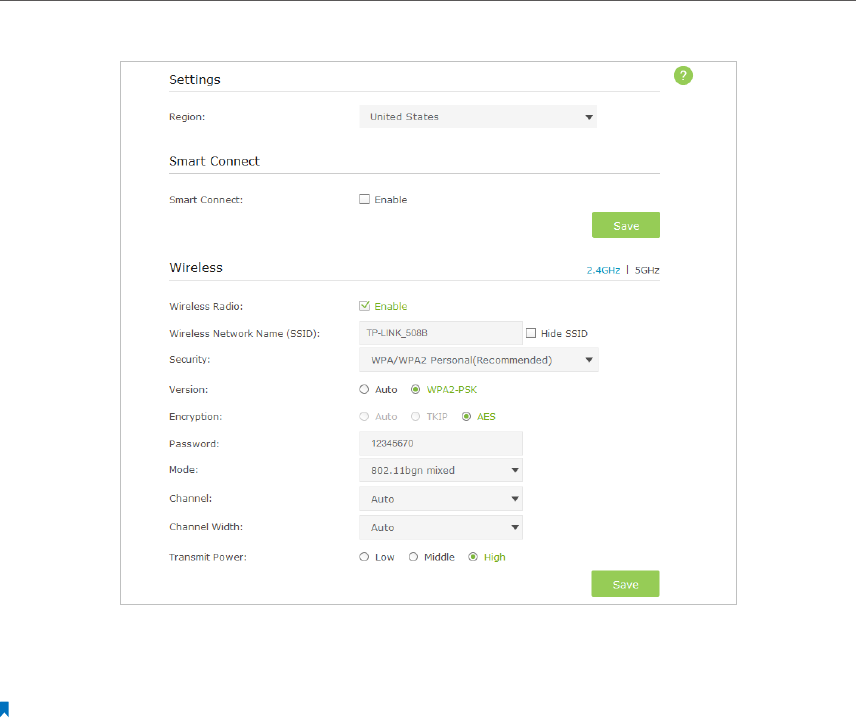
79
Chapter 12 Customize Your Network Settings
To change the working region for the router:
Select the Region from the drop-down list and click Save.
Note: Per FCC regulations, all Wi-Fi products marketed in the U.S. is locked to the U.S. region.
To use the smart connect function
The smart connect function helps devices run faster by assigning them to best wireless
bands based on actual conditions to balance network demands.
1. Select the Smart Connect checkbox, and click Save.
2. Keep the default or set a new SSID and password, and click Save.
This SSID and password will be applied for 2.4GHz, 5GHz wireless networks.
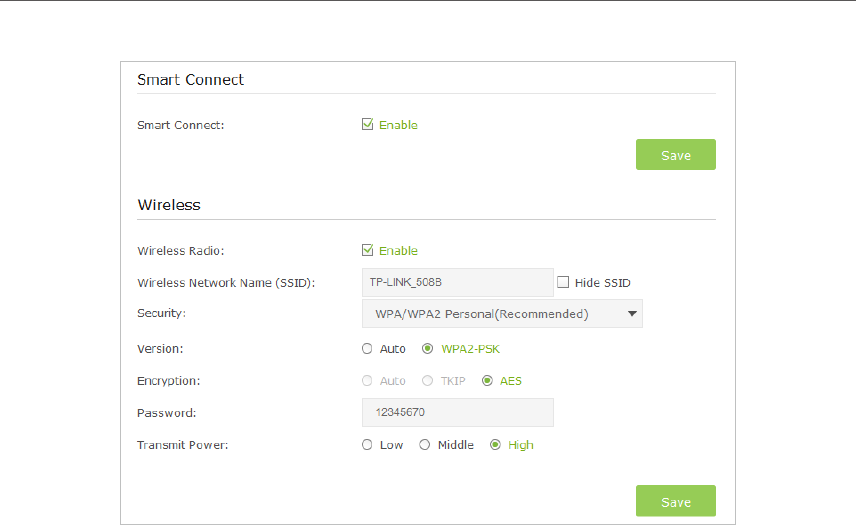
80
Chapter 12 Customize Your Network Settings
To change the security option:
In the Wireless section, select an option from the Security dropdown list.
The router provides four security options, No Security, WPA/WPA2 - Personal
(Recommended), WPA/WPA2 - Enterprise and WEP. We recommend you don’t change
the default settings unless necessary. If you select other options, configure the related
parameters according to the help page.
In addition
• Mode - Select a transmission mode according to your wireless client devices.
802.11b/g/n mixed, 802.11g/n mixed or 802.11n only for 2.4GHz; and 802.11a/n/ac
mixed, 802.11n/ac mixed or 802.11ac only for 5GHz. It is recommended to just leave
it as default.
• Channel Width - Select a channel width (bandwidth) for the wireless network.
• Channel - Select an operating channel for the wireless network. It is recommended
to leave the channel to Auto, if you are not experiencing the intermittent wireless
connection issue.
• Transmit Power - Select either High, Middle or Low to specify the data transmit power.
The default and recommended setting is High.
12. 7. Use WPS for Wireless Connection
Wi-Fi Protected Setup(WPS) gives consumers an easier approach to set up a security-
protected Wi-Fi connection.
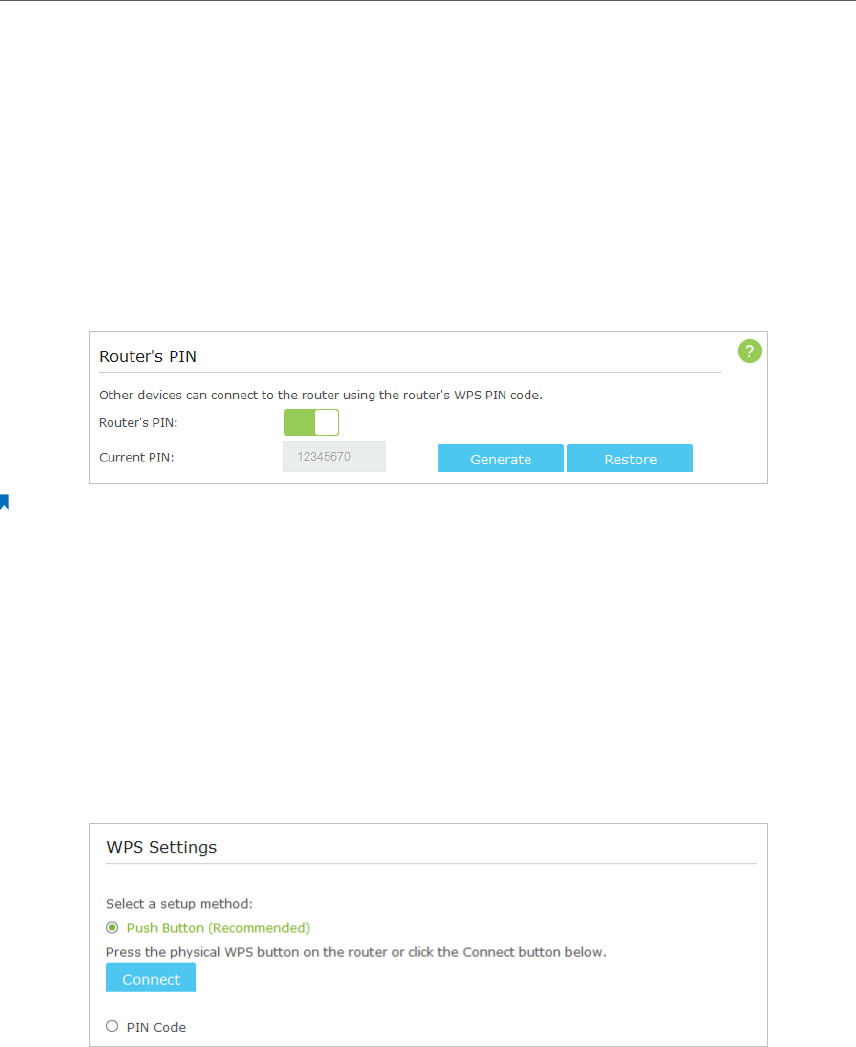
81
Chapter 12 Customize Your Network Settings
1. Visit http://tplinkwifi.net, and log in with the username and password you set for the
router.
2. Go to Advanced > Wireless > WPS .
12. 7. 1. Set the Router’s PIN
Router’s PIN is enabled by default to allow wireless devices to connect to the router
using the PIN. You can use the default one or generate a new one.
Note:
1. If you want to enable/disable the WPS feature, go to System Tools > System Parameters > WPS, select or clear the
Enable WPS check box.
2. PIN (Personal Identification Number) is an eight-character identification number preset to each router. WPS
supported devices can connect to your router with the PIN. The default PIN is labeled on the bottom of the router.
12. 7. 2. Use the WPS Wizard for Wi-Fi Connections
1. Select a setup method:
• Push Button (Recommended): Click the Connect button on the screen. Within
two minutes, push the WPS button on the client device.
• PIN Code: Enter the client’s PIN, and click Connect.
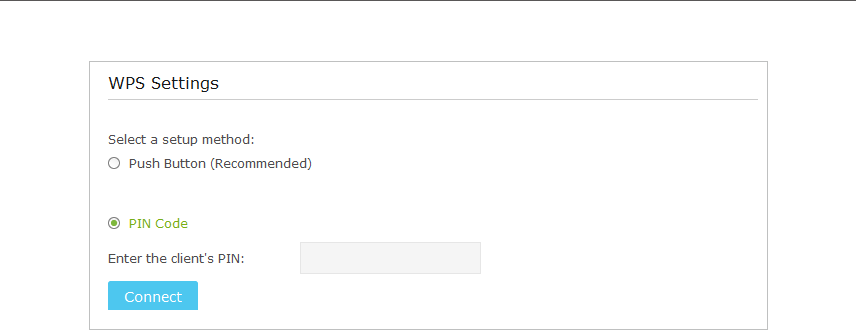
82
Chapter 12 Customize Your Network Settings
2. Success will appear on the above screen and the WPS LED on the router will keep on
for five minutes if the client has been successfully added to the network.
12. 8. Schedule Your Wireless Function
You can automatically turn off your wireless network at the time when you do not need
the wireless connection.
1. Visit http://tplinkwifi.net, and log in with the username and password you set for the
router.
2. Go to Advanced > Wireless > Wireless Schedule page.
3. Select the 2.4GHz wireless network to configure. Toggle on the button to enable the
Wireless Schedule feature.
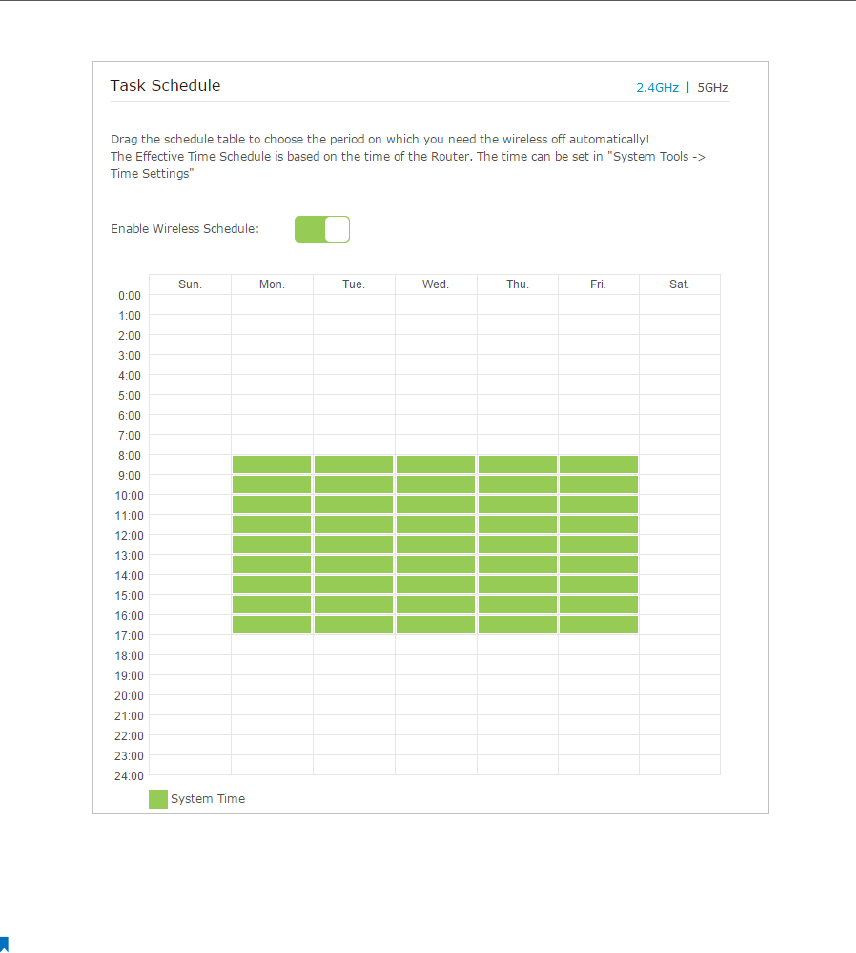
83
Chapter 12 Customize Your Network Settings
4. Set the time. Drag the cursor to cover the time area and click Save to make the
settings effective. The selected time will be in green.
5. Repeat steps 3 and 4 to set time for 5GHz wireless networks.
Note:
1. If you just set time for one wireless band, the other wireless band is still always on, so set time for both of the two
bands to schedule your whole wireless network.
2. The wireless LED (2.4GHz , 5GHz ) will turn off if the corresponding wireless network is disabled.
3. The wireless network will be automatically turned on after the time period you set.
12. 9. Set up a VPN Connection
VPN (Virtual Private Network) is a private network established across the public network,
generally via the Internet. However, the private network is a logical network without
any physical network lines, so it is called Virtual Private Network.
With the wide application of the Internet, more and more data are needed to be shared
through the Internet. Connecting the local network to the Internet directly, though can

84
Chapter 12 Customize Your Network Settings
allow the data exchange, will cause the private data to be exposed to all the users on
the Internet.
The VPN (Virtual Private Network) technology is developed and used to establish
the private network through the public network, which can provides a secure
communication to a remote computer or remote network, and guarantee a secured
data exchange. IPSec is one of the major implementations of VPNs.
Establish an IPSec VPN tunnel to connect two LANs via Internet so
that the hosts in different remote LANs are able to communicate
with each as if they are in the same LAN.
For example, I am the network administrator of a regional office,
I need to let my office staff can visit the headquarter’s servers
and resources, and vice versa. I know that the router in my office
and the device in headquarter both support IPSec VPN feature,
so I decide to set up a VPN connection with the headquarter
office.
The following diagram is a typical VPN topology. Here Site A
refers to regional office’s network (local network). And Site B
refers to the headquarter’s network (remote network) which I
want to connect.
LAN: 192.168.1.1
WAN: 219.134.112.246
PC 1
Subnetmask: 255.255.255.0
WAN: 219.134.112.247
PC 2
LAN: 192.168.2.1
Subnetmask: 255.255.255.0
Site A Site B
1. Make sure of the topology you want to build and record site
A (local network) and site B (remote network)’s LAN IP and
WAN IP.
2. Configuration on site A (local network).
1 ) Visit http://tplinkwifi.net, and log in with the username
and password you set for the router.
2 ) Go to Advanced > Network > IPSec VPN to open the
configuration page. Click Add to set up a VPN tunnel.
I want to:
How can I
do that?
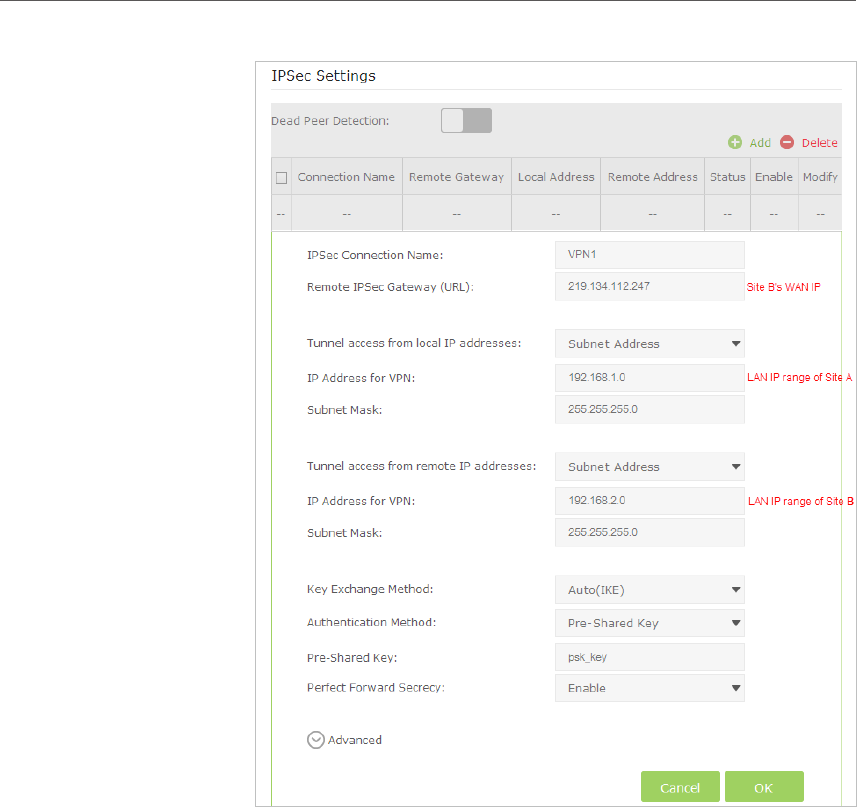
85
Chapter 12 Customize Your Network Settings
3 ) In the IPSec Connection Name column, specify a name.
4 ) In the Remote IPSec Gateway (URL) column, Enter Site B’s
WAN IP address.
5 ) To configure Site A’s LAN:
In the Tunnel access from local IP addresses column, here we
take Subnet Address as an example. Then input the LAN IP
range of Site A in the IP Address for VPN column, and input
Subnet Mask of Site A.
6 ) To configure Site B’s LAN:
In the Tunnel access from remote IP addresses column, here
we take Subnet Address as an example. Then input the LAN
IP range of Site B in the IP Address for VPN column, and input
Subnet Mask of Site B.
7 ) Select the Key Exchange Method for the policy. We select
Auto(IKE) here.
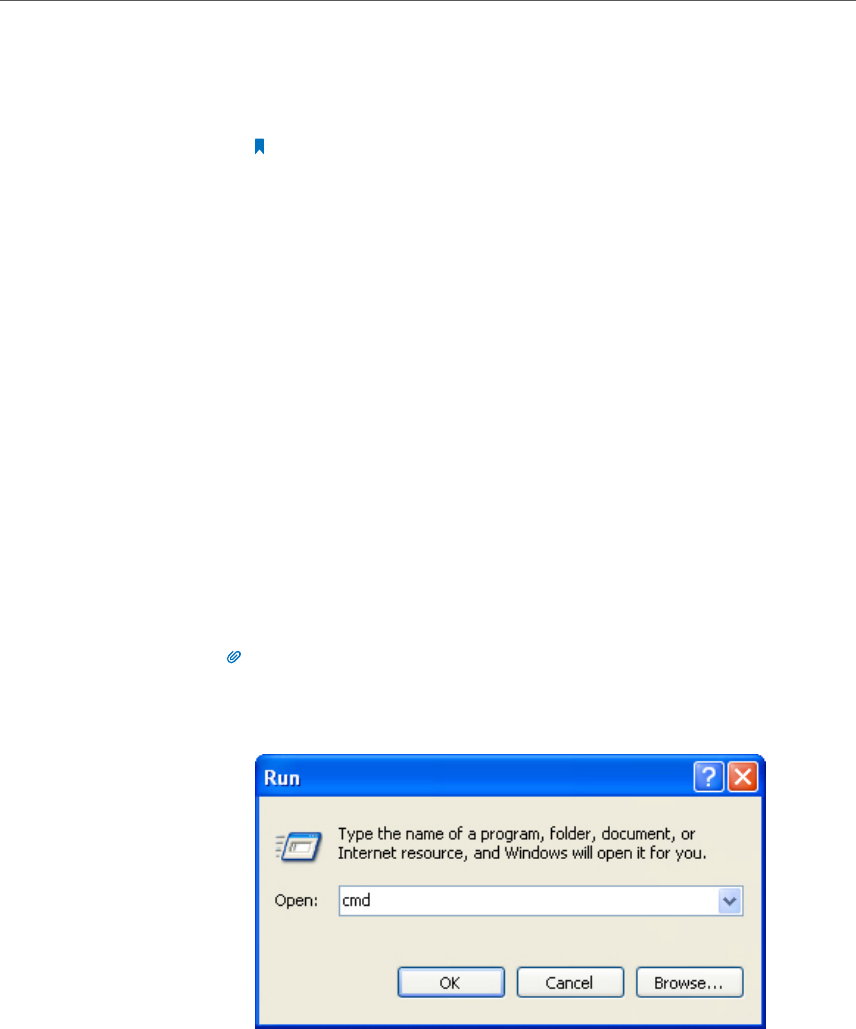
86
Chapter 12 Customize Your Network Settings
8 ) Enter the Pre-Shared Key for IKE authentication. Then
keep Perfect Forward Secrecy enabled.
Note:
• The key should consist of visible characters without blank space.
• Make sure Site A and Site B use the same key.
9 ) Leave the Advanced Settings as default value. Then click
OK to save.
3. Configuration on Site B (remote network). Refer to step 2
configuration on Site A and make sure that Site A and Site B
use the same Pre-shared keys and Perfect Forward Secrecy
settings.
4. The Status column will change to UP if the VPN connection
has been set up successfully.
5. Check the VPN connection. You can ping site B’ LAN IP
from your computer in site A to verify that the IPSec VPN
connection is set up correctly.
Tips: To check the VPN connection, you can do the following.
a . On the host in Site A, press [Windows Logo] + [R] to open
Run dialog. Input “cmd” and hit OK.
b . In the CLI window, type in “ping 192.168.2.x” (“192.168.2.x”
can be IP address of any host in Site B). Then press [Enter].
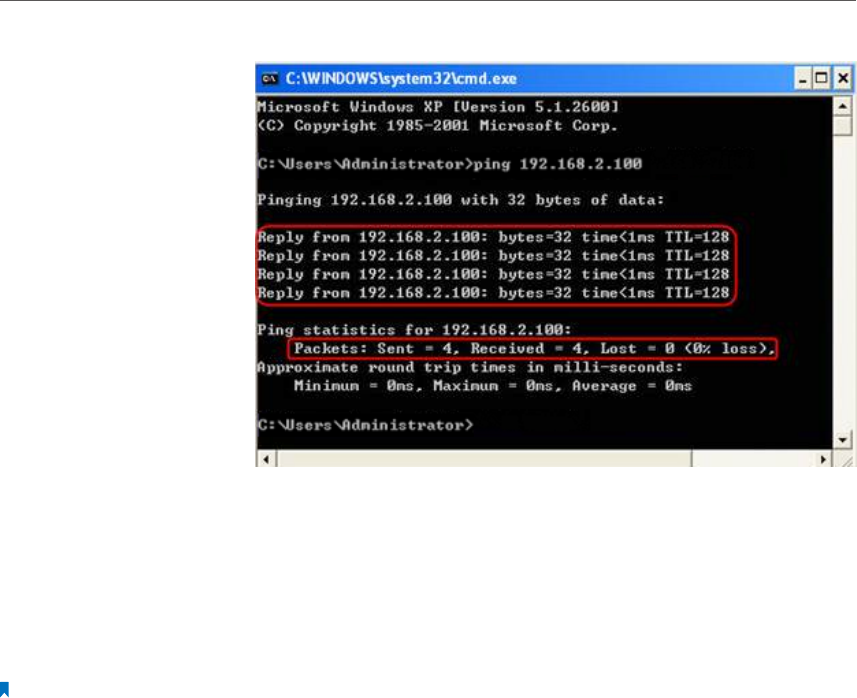
87
Chapter 12 Customize Your Network Settings
If Ping proceeds successfully (gets replies from host in Site B),
the IPSec connection is working properly now.
Now IPSec VPN is implemented to establish a connection.
Note:
1. The product supports a maximum of ten simultaneous connections.
2. If one of the site has been off line for a while, for example, if Site A has been disconnected, on Site B you need to
click Disable and then click Enable after Site A back on line in order to re-establish the IPSec tunnel.
Done!

Chapter 13
Manage the Router
This chapter will show you the configuration for managing and maintaining your
router.
This chapter includes the following sections:
• Set Up System Time
• Test the Network Connectivity
• Upgrade the Firmware
• Backup and Restore Configuration Settings
• Change the Administrator Account
• Local Management
• Remote Management
• System Log
• SNMP Settings
• Monitor the Internet Traffic Statistics
• Control LEDs
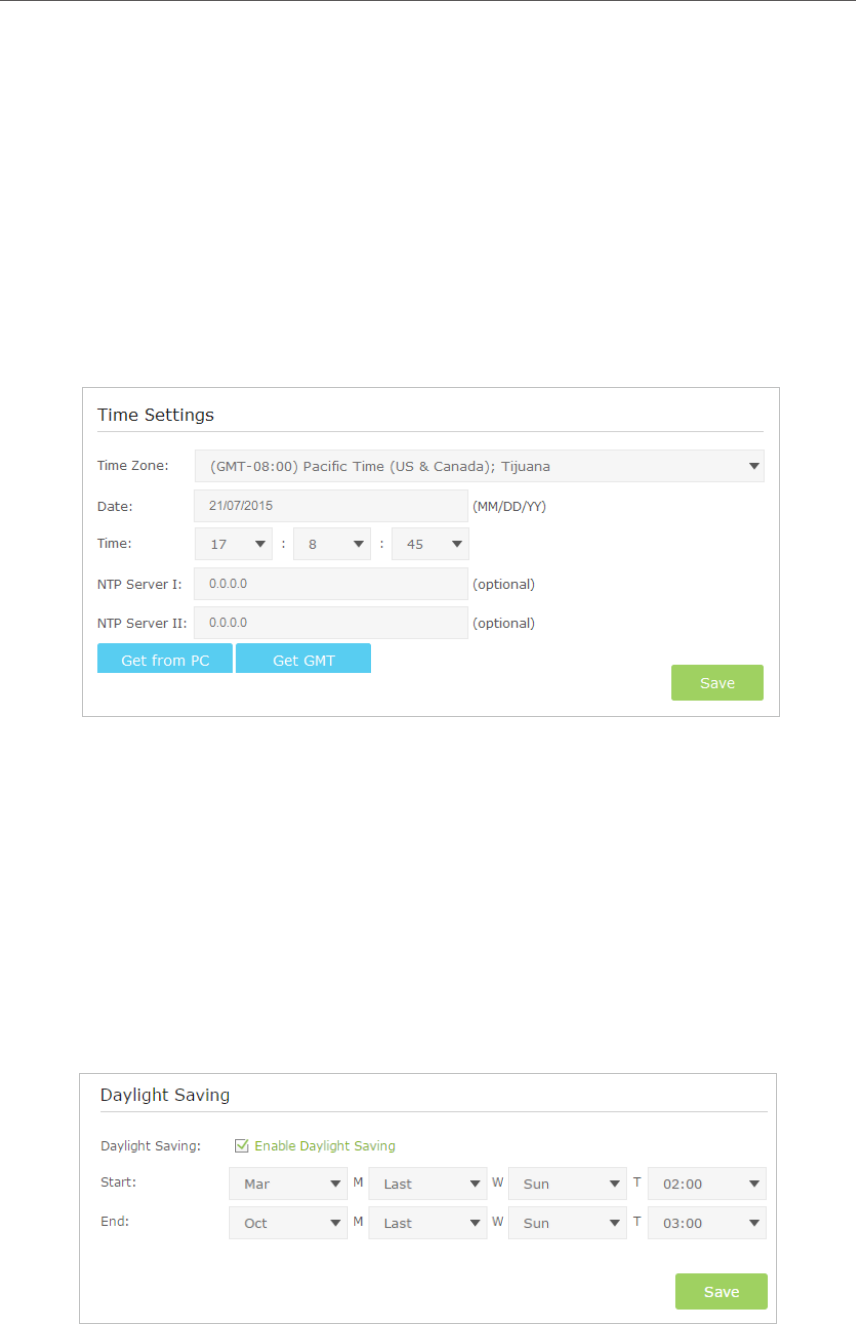
89
Chapter 13 Manage the Router
13. 1. Set Up System Time
System time is the time displayed while the router is running. The system time you
configure here will be used for other time-based functions like Parental Controls and
Wireless Schedule. You can manually set how to get the system time.
Follow the steps below to set your system time.
1. Visit http://tplinkwifi.net, and log in with the username and password you set for the
router.
2. Go to Advanced > System Tools > Time Settings page.
3. Configure the system time using the following methods :
Manually: Select your time zone and enter your local time.
Get from PC: Click this button if you want to use the current managing PC’s time.
Get GMT: Click this button if you want to get time from the Internet. Make sure your
router can access the Internet before you select this way to get system time.
4. Click Save to make your settings effective.
5. After setting the system time, you can set Daylight Saving time according to your
needs. Tick the checkbox to enable Daylight Saving, set the start and end time and
then click Save to make the settings effective.
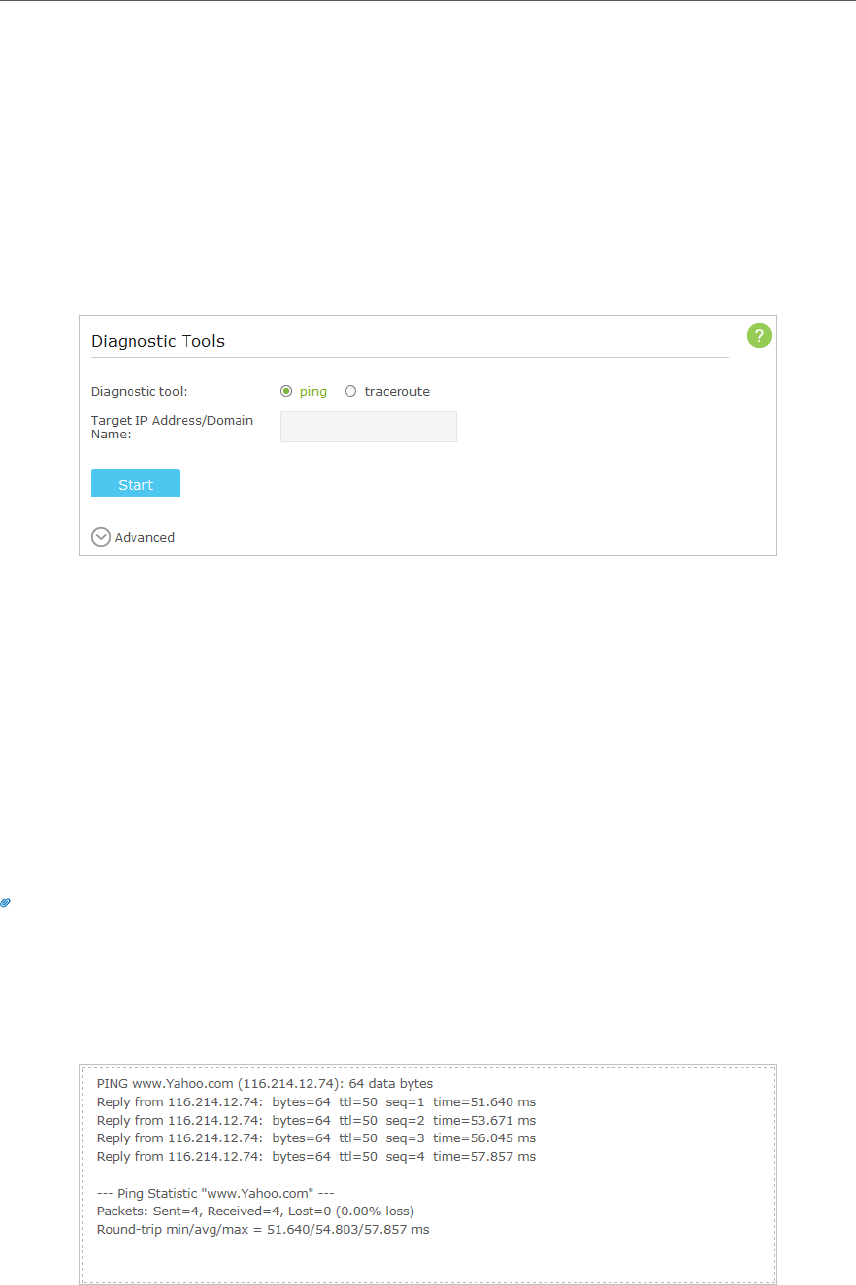
90
Chapter 13 Manage the Router
13. 2. Test the Network Connectivity
Diagnostics is used to test the connectivity between the router and the host or other
network devices.
1. Visit http://tplinkwifi.net, and log in with the username and password you set for the
router.
2. Go to Advanced > System Tools > Diagnostics.
3. Enter the information with the help of page tips:
1 ) Choose Ping or Traceroute as the diagnostic tool to test the connectivity;
• Ping is used to test the connectivity between the router and the tested host,
and measure the round-trip time.
• Traceroute is used to display the route (path) your router has passed to reach
the tested host, and measure transit delays of packets across an Internet
Protocol network.
2 ) Enter the Target IP Address/Domain Name of the tested host.
4. Click Start to begin the diagnostics.
Tips:
Click Advanced, you can modify the packet count, packet size, test timeout time or max hop. It’s recommended to
keep the default value.
The figure below indicates the proper connection between the router and the Yahoo
server (www.Yahoo.com) tested through Ping.
The figure below indicates the proper connection between the router and the Yahoo
server (www.Yahoo.com) tested through Traceroute.
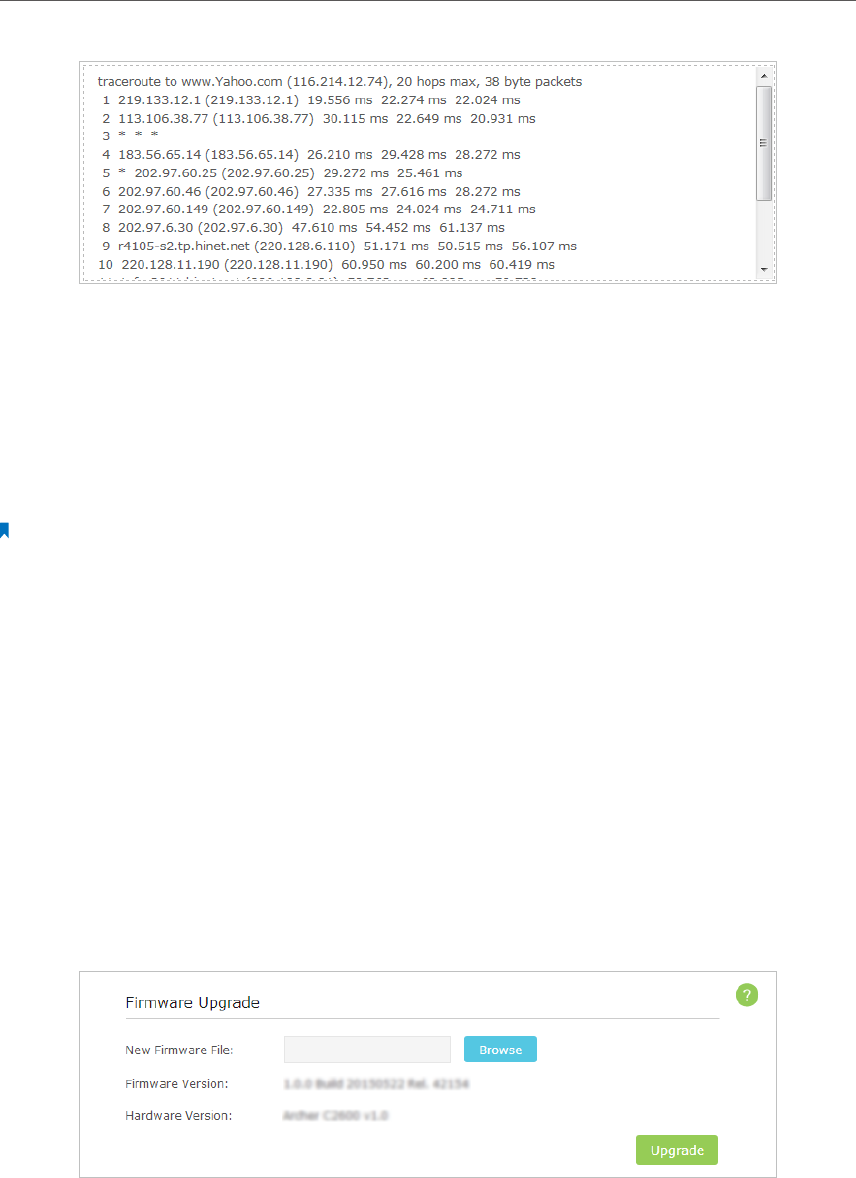
91
Chapter 13 Manage the Router
13. 3. Upgrade the Firmware
TP-LINK is dedicated to improving and richening the product features, giving you a
better network experience. We will release the latest firmware at TP-LINK official website,
you can download the latest firmware file from the Support page of our website www.
tp-link.com and upgrade the firmware to the latest version.
Note:
1. Make sure the latest firmware file is matched with the hardware version (as shown in the webpage).
2. Make sure that you have a stable connection between the router and your computer. It is NOT recommended to
upgrade the firmware wirelessly.
3. Make sure you remove any USB storage device connected to the router before the firmware upgrade to prevent
data loss.
4. Backup your router configuration.
5. Do NOT turn off the router during the firmware upgrade.
Follow the steps to upgrade the firmware.
1. Download the latest firmware file for the router from our website www.tp-link.com.
2. Visit http://tplinkwifi.net, and log in with the username and password you set for the
router.
3. Go to Advanced > System Tools > Firmware Upgrade.
4. Click Browse to locate the downloaded new firmware file, and click Upgrade.
5. Wait a few moments for the upgrading and rebooting.
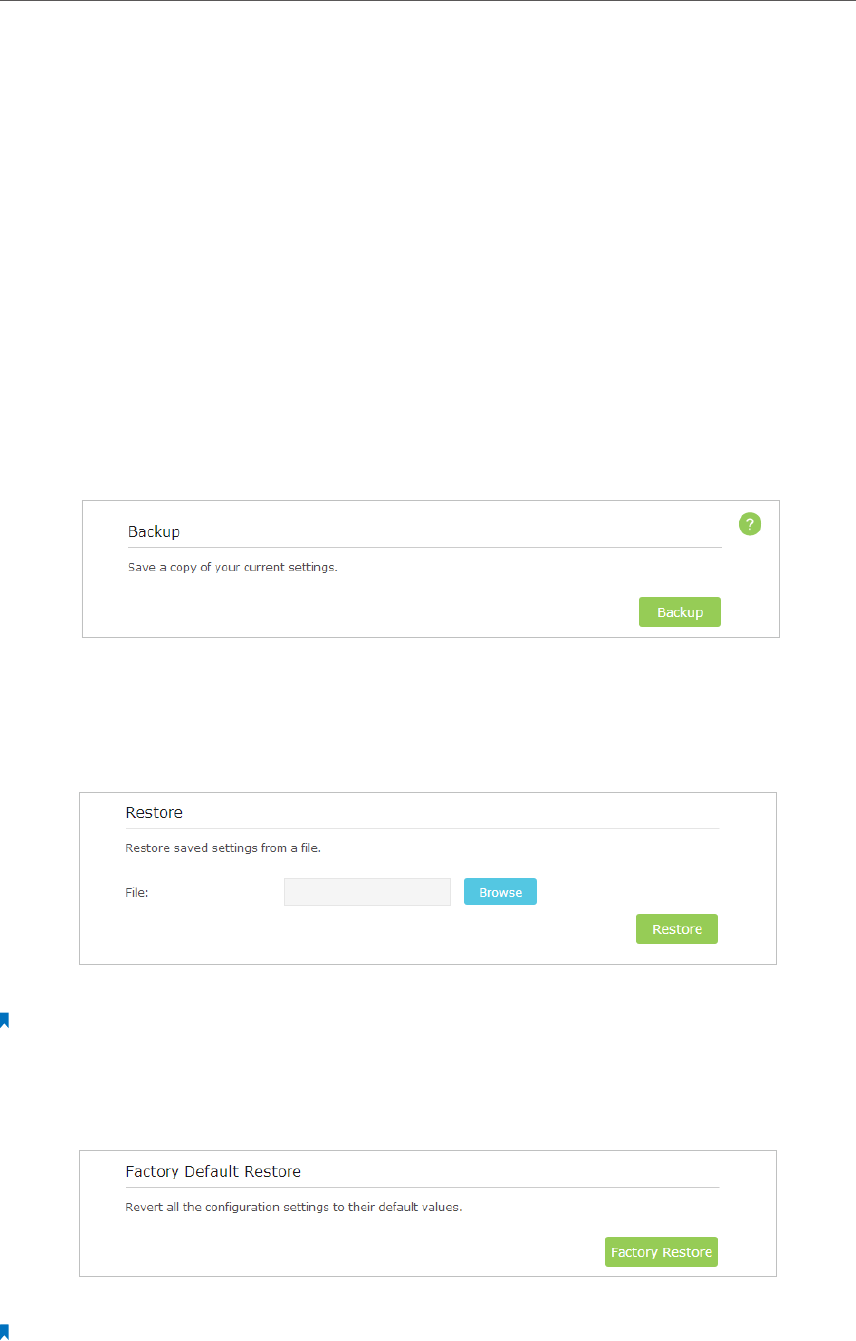
92
Chapter 13 Manage the Router
13. 4. Backup and Restore Configuration Settings
The configuration settings are stored as a configuration file in the router. You can
backup the configuration file to your computer for future use and restore the router to
a previous settings from the backup file when needed. Moreover, if necessary you can
erase the current settings and reset the router to the default factory settings.
1. Visit http://tplinkwifi.net, and log in with the username and password you set for the
router.
2. Go to Advanced > System Tools > Backup & Restore.
To backup configuration settings:
Click Backup to save a copy of the current settings to your local computer. A ‘.bin’ file of
the current settings will be stored to your computer.
To restore configuration settings:
1. Click Browse to locate the backup configuration file stored on your computer, and
click Restore.
2. Wait a few moments for the restoring and rebooting.
Note: During the restoring process, do not turn off or reset the router.
To reset the router to factory default settings:
1. Click Factory Restore to reset the router.
2. Wait a few moments for the reset and reboot.
Note:
1. During the resetting process, do not turn off or reset the router.
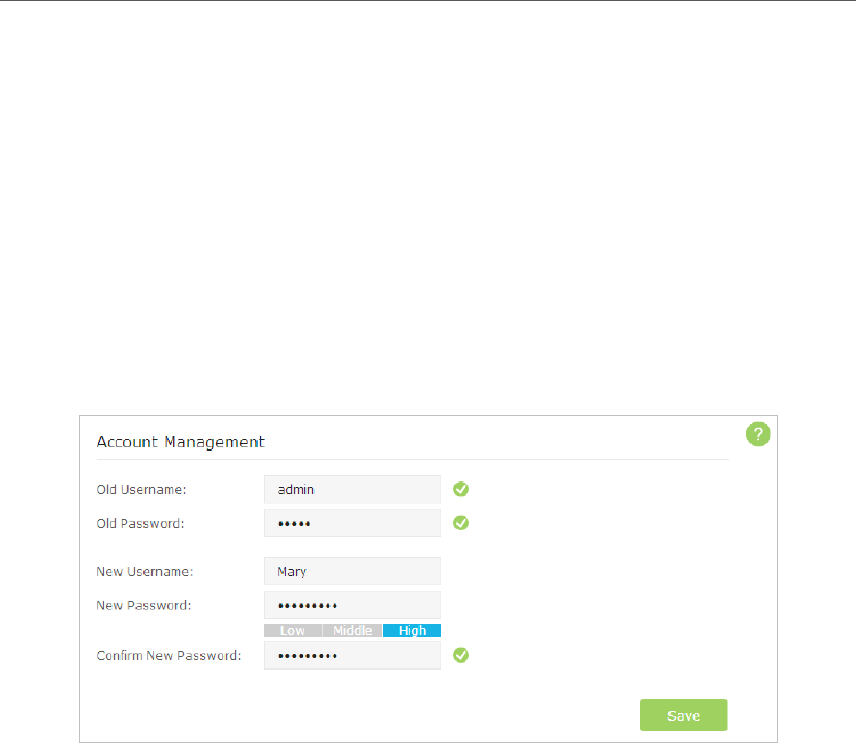
93
Chapter 13 Manage the Router
2. We strongly recommend you backup the current configuration settings before resetting the router.
13. 5. Change the Administrator Account
The account management feature allows you to change your login username and
password of the web-based management page.
1. Visit http://tplinkwifi.net, and log in with the username and password you set for the
router before.
2. Go to Advanced > System Tools > Administration and complete the settings in Account
Management section.
3. Enter the old username and old password. Enter the new username and enter the
new password twice (both case-sensitive). Click Save.
Use the new username and password for the following logins.
13. 6. Local Management
You can control the local devices’ authority to manage the router via Local Management
feature. By default all local connected devices are allowed to manage the router. You
can also allow only one device to manage the router.
Follow the steps below to specify the local management.
1. Visit http://tplinkwifi.net, and log in with the username and password you set for the
router.
2. Go to Advanced > System Tools> Administration page. Locate the Local Management
section.
3. Keep the Port as the default setting. Enter the IP address or MAC address of the local
device to manage the router.
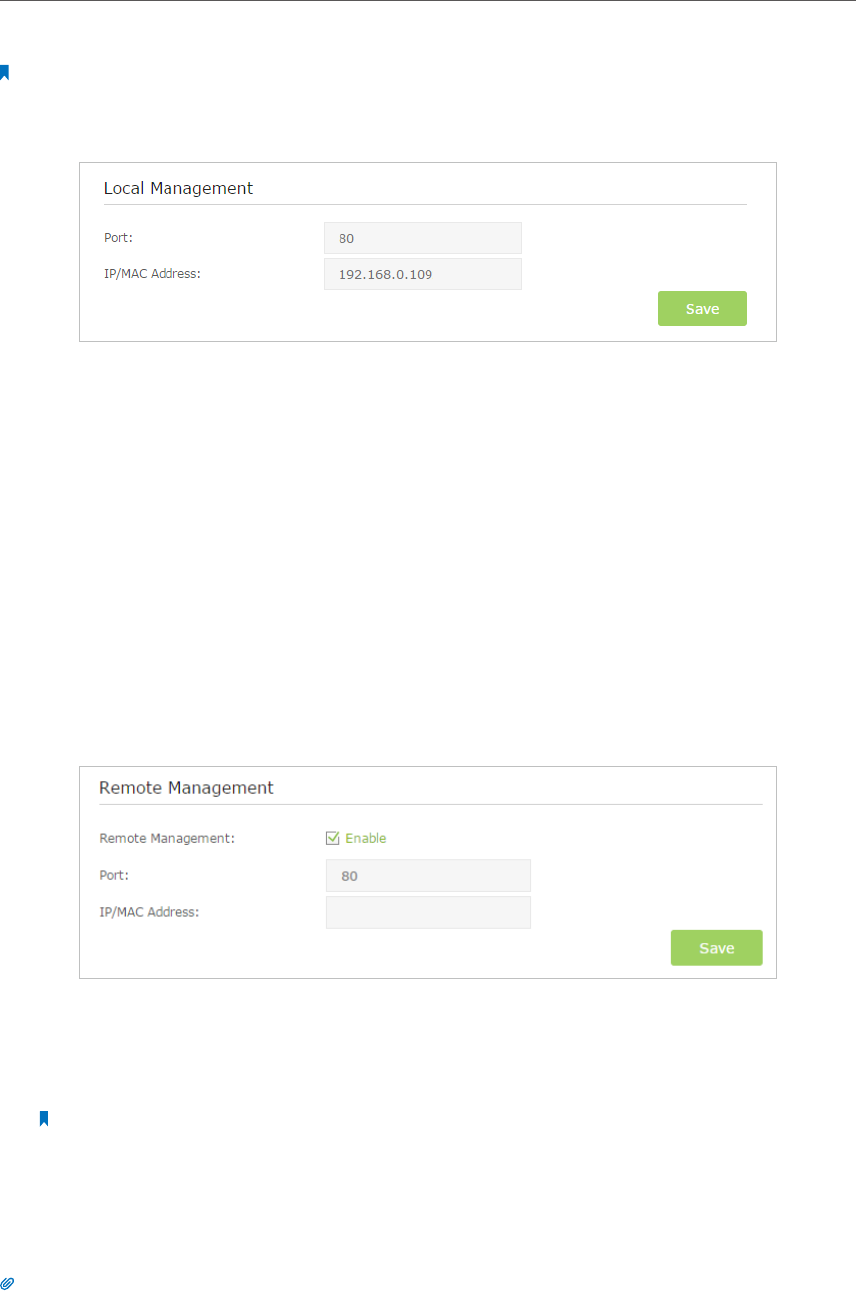
94
Chapter 13 Manage the Router
Note:
1. The IP address of the local device must be in the same subnet as the router’s LAN IP address.
2. If you want that all local devices can manage the router, just leave the IP/MAC Address field blank.
4. Click Save to make the settings effective. Now only the device using the IP address or
MAC address you set can manage the router.
13. 7. Remote Management
By default, the remote devices are not allowed to manage the router from the Internet.
Follow the steps below to allow remote devices to manage the router.
1. Visit http://tplinkwifi.net, and log in with the username and password you set for the
router.
2. Go to Advanced > System Tools> Administration page. Locate the Remote Management
section.
3. Tick the checkbox to enable Remote Management.
4. Keep the Port as the default setting. Enter the IP address or MAC address of the
remote device to manage the router.
Note: If you want that all remote devices can manage the router, just leave the IP/
MAC Address field blank.
5. Click Save to make the settings effective. Now, only the device using the IP address
or MAC address you set can log in to http://router’s Internet IP address:port number
(such as http://113.116.60.229:80) to manage the router remotely.
Tips:
1. You can find the Internet IP address of the router on Basic > Network Map > Internet.
2. The router’s Internet IP is usually a dynamic IP. Please refer to Set Up a Dynamic DNS Service Account if you want to
log in to the router through a domain name.
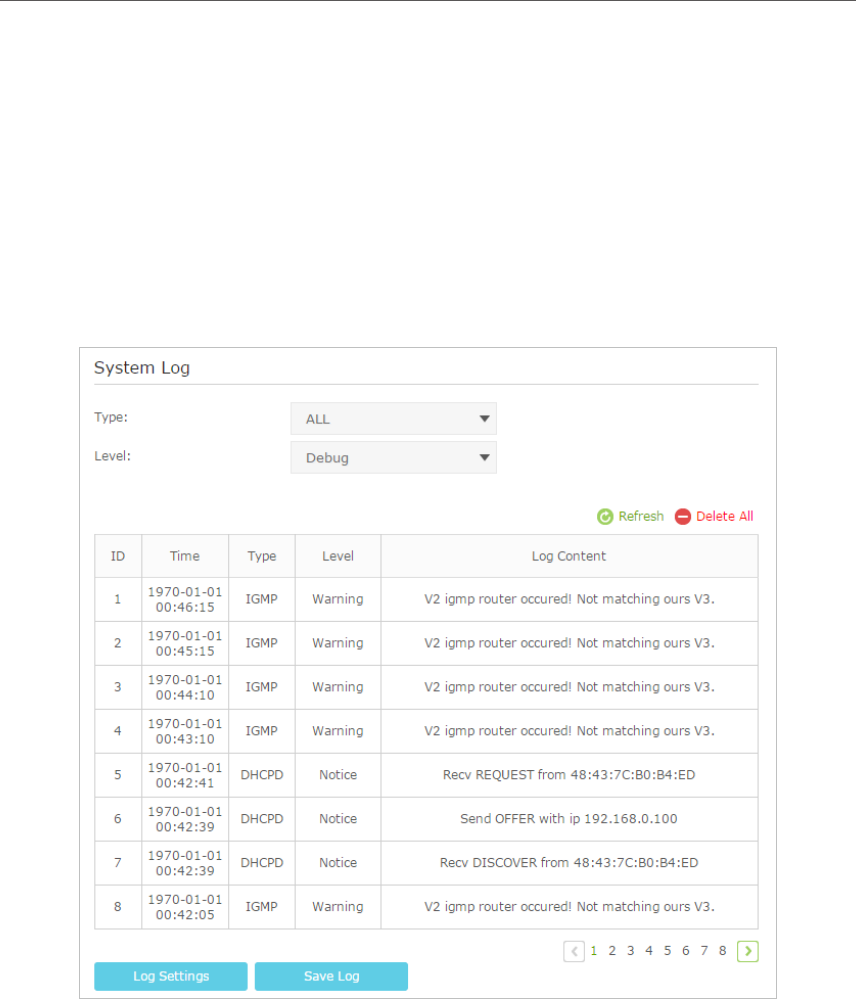
95
Chapter 13 Manage the Router
13. 8. System Log
System Log can help you know what happened to your router, facilitating you to locate
the malfunctions. For example when your router does not work properly, you will need
to save the system log and send it to the technical support for troubleshooting.
1. Visit http://tplinkwifi.net, and log in with the username and password you set for the
router.
2. Click Advanced > System Tools > System Log page.
To view the system logs:
1. Select the log Type. Select ALL to view all kinds of logs, or select IGMP or PPP to view
the specific logs.
2. Select the log Level and you will see the logs with the specific or higher levels.
3. Click Refresh to refresh the log list.
To save the system logs:
You can choose to save the system logs to your local computer or a remote server.
Click Save Log to save the logs in a txt file to your computer.
Click Log Settings to set the save path of the logs.
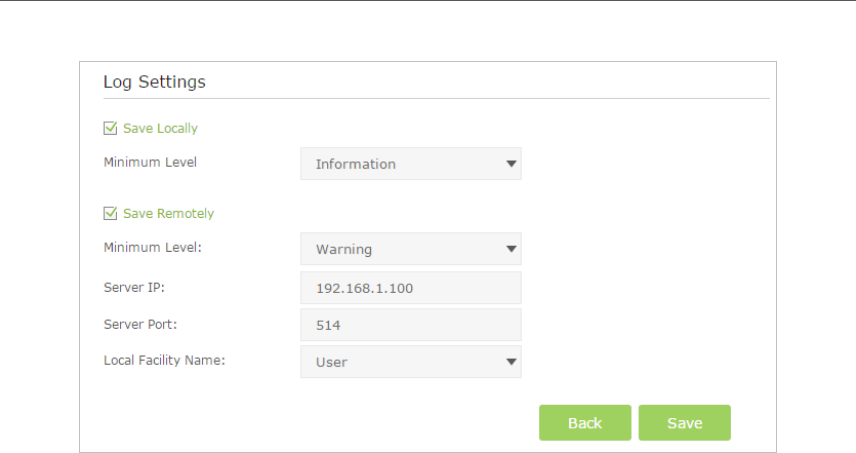
96
Chapter 13 Manage the Router
• Save Locally: Select this option to cache the system log to the router’s local memory,
select the minimum level of system log to be saved from the drop-down list. The logs
will be shown in the table in descending order on the System Log page.
• Save Remotely: Select this option to send the system log to a remote server, select
the minimum level of system log to be saved from the drop-down list and enter the
information of the remote server. If the remote server has a log viewer client or a
sniffer tool implemented, you can view and analyze the system log remotely in real-
time.
13. 9. SNMP Settings
SNMP (Simple Network Management Protocol) has been widely applied in the computer
networks currently, which is used for ensuring the transmission of the management
information between two nodes. In this way, network administrators can easily search
and modify the information on any node on the network. Meanwhile, they can locate
faults promptly and implement the fault diagnosis, capacity planning and report
generating.
An SNMP Agent is an application running on the router that performs the operational
role of receiving and processing SNMP messages, sending responses to the SNMP
manager, and sending traps when an event occurs. So a router contains SNMP “agent”
software can be monitored and/or controlled by SNMP Manager using SNMP messages.
1. Visit http://tplinkwifi.net, and log in with the username and password you set for the
router.
2. Go to Advanced > System Tools > SNMP Settings page.
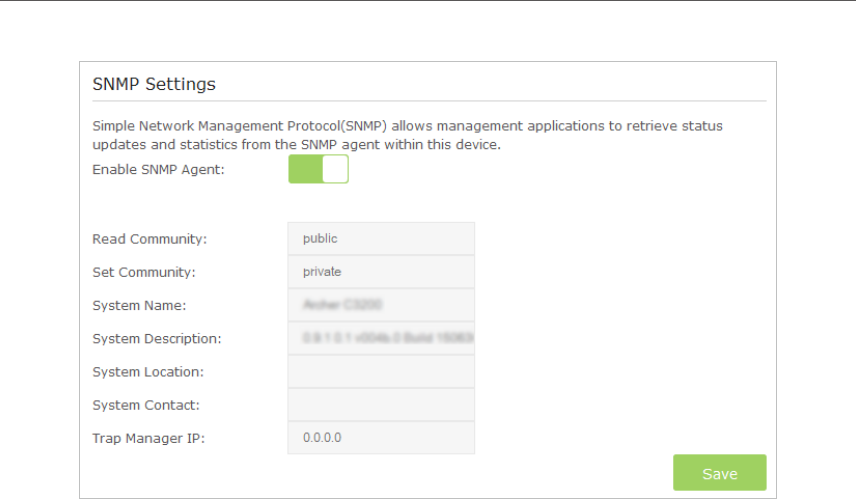
97
Chapter 13 Manage the Router
• Enable SNMP Agent: Toggle On to enable the built-in SNMP agent that allows
the router to operate as the operational role in receiving and processing of SNMP
messages, sending responses to the SNMP manager, and triggering SNMP traps
when an event occurs.
• Read-only Community: Displays the default public community string that protects
the router from unauthorized access.
• Set Community: Displays the default read and write community string that protects
the router from unauthorized changes.
• System Name: Displays the administratively-assigned name for this managed device.
• System Description: Displays the textual description of the managed device. This
value should include the full name and version identification of the system’s hardware
type, software operating-system, and networking software.
• System Location: Displays the physical location of this device (e.g., telephone closet,
3rd floor).
• System Contact: Displays the textual identification of the contact person for this
managed device, together with information on how to contact this person.
• Trap Manager IP: Displays the IP address of the host to receive the traps.
You are suggested to keep the default settings. Click Save to make the settings effective.
13. 10. Monitor the Internet Traffic Statistics
The Traffic Statistics page displays the network traffic of the LAN, WAN and WLAN sent
and received packets, allows you to monitor the volume of Internet traffic statistics.
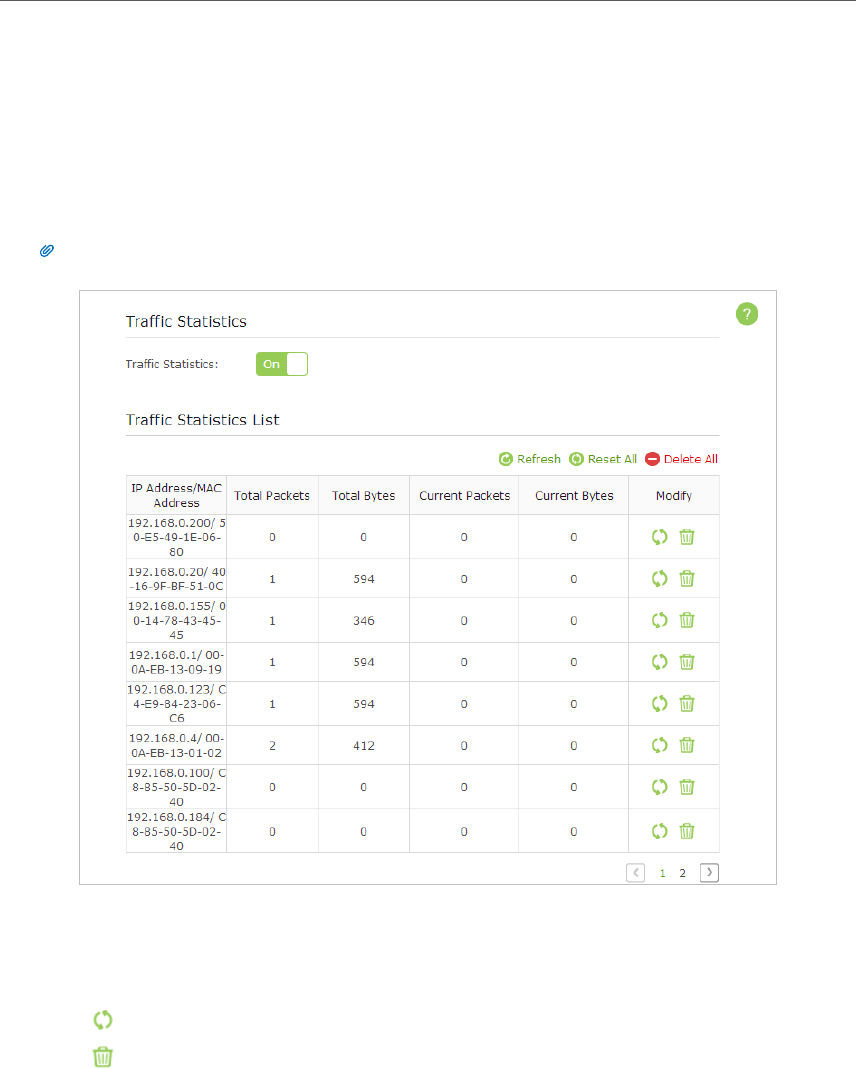
98
Chapter 13 Manage the Router
1. Visit http://tplinkwifi.net, and log in with the username and password you set for the
router.
2. Go to Advanced > System Tools > Traffic Statistics.
3. Toggle on Traffic Statistics, and then you can monitor the traffic statistics in Traffic
Statistics List section.
Tips: This function is enabled by default.
Click Refresh to update the statistic information on the page.
Click Reset All to reset all statistic values in the list to zero.
Click Delete All to delete all statistic information in the list.
Click to reset the statistic information of the specific device.
Click to delete the specific device item in the list.
13. 11. Control LEDs
The router LEDs indicate router activities and behavior. You can turn on or turn off the
router from the web-based management page.
1. Visit http://tplinkwifi.net, and log in with the username and password you set for the
router.
2. Go to Advanced > System Tools > System Parameters.
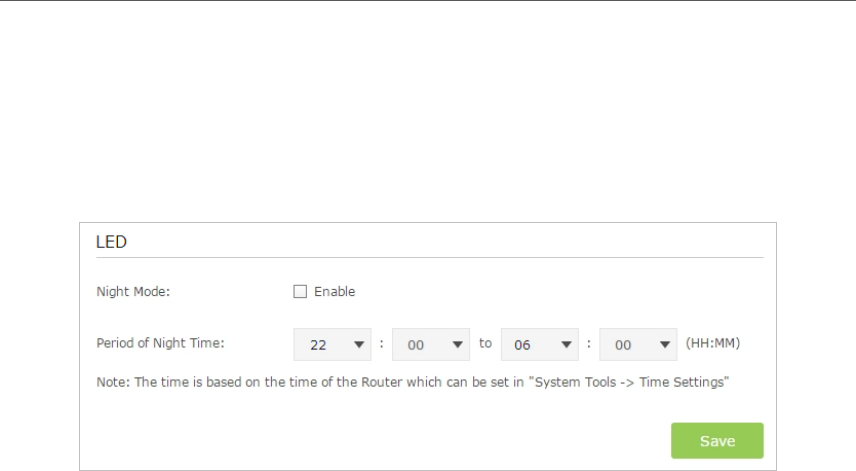
99
Chapter 13 Manage the Router
3. In the LED section, enable the Night Mode.
4. Specify a time period according to your needs, and the LEDs will be off during the
period.
5. Click Save to make the settings effective.

100
FAQ
Q1. What can I do if I forgot my wireless password?
The default password is labeled at the back of the router. If the password has been altered, please
connect the router to the computer using a cable and follow the steps below:
1. Visit http://tplinkwifi.net, and log in with the username and password you set for the router.
2. Go to Basic > Wireless to obtain your wireless password.
Q2. How to retrieve the username and password of the web management page?
The default username and password of the web management page are admin (in lower case). If the
password has been altered, please follow the steps below:
1. Reset the router to factory default settings: Press and hold the Reset button for about 7 seconds
and then release;
2. Visit http://tplinkwifi.net;
3. Enter admin (in lower case) as both username and password to login.
Note: You’ll need to reconfigure the router to surf the Internet once the router is reset, and please mark down your new password
for future use.
Q3. I cannot login to the router’s web management page, what can I do?
This can happen for a variety of reasons, please try the methods below and try again.
1. Make sure the router connects to the computer correctly and the corresponding LED indicator(s)
light up.
2. Make sure the IP address of your computer is configured as Obtain an IP address automatically
and Obtain DNS server address automatically.
3. Make sure the http://tplinkwifi.net you input is right.
4. Check your computer’s settings:
1 ) Go to Start > Control Panel > Network and Internet, and click View network status and tasks;
2 ) Click Internet Options on the bottom left;
3 ) Click Connections, select Never dial a connection;
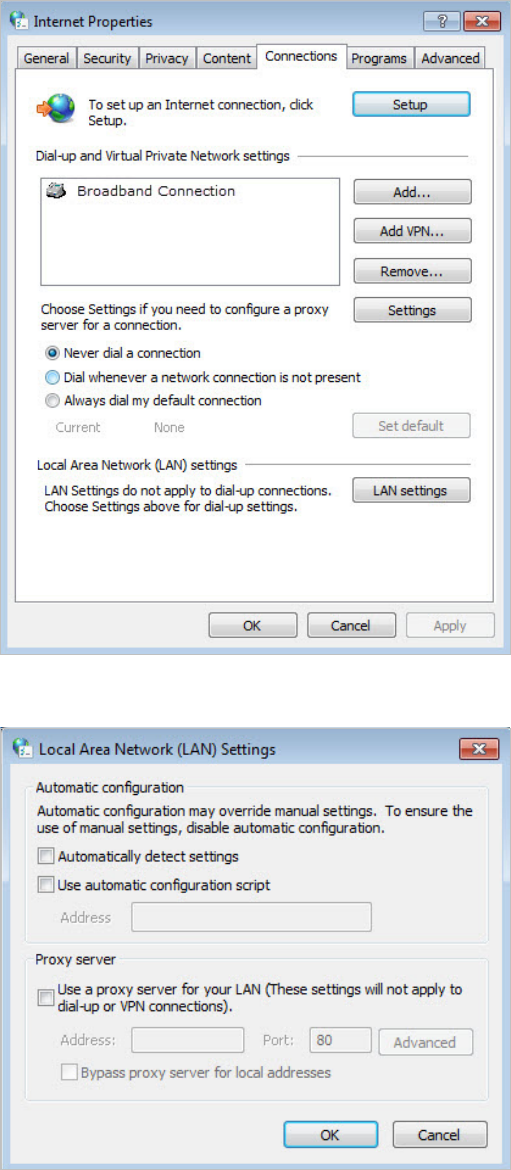
101
4 ) Click LAN settings, deselect the following three options and click OK;
5 ) Go to Advanced > Restore advanced settings, click OK to save the settings.
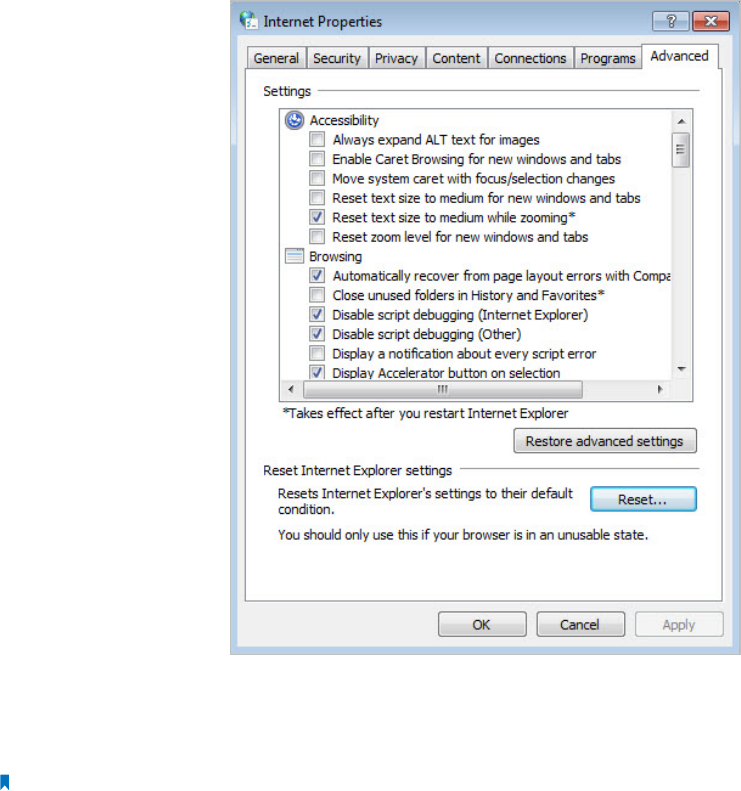
102
5. Change a web browser or computer and login again.
6. Reset the router to factory default settings: Press and hold the Reset button for about 7 seconds
and then release.
Note: You’ll need to reconfigure the router to surf the Internet once the router is reset.
Open a web browser and login again. If login still fails, please contact the technical support.
Q4. I cannot access the Internet even though the configuration is finished, what
can I do?
1. Visit http://tplinkwifi.net, and log in with the username and password you set for the router.
2. Go to Advanced > Status to check Internet status:
¾If IP Address is a valid IP address, please try the methods below and try again:
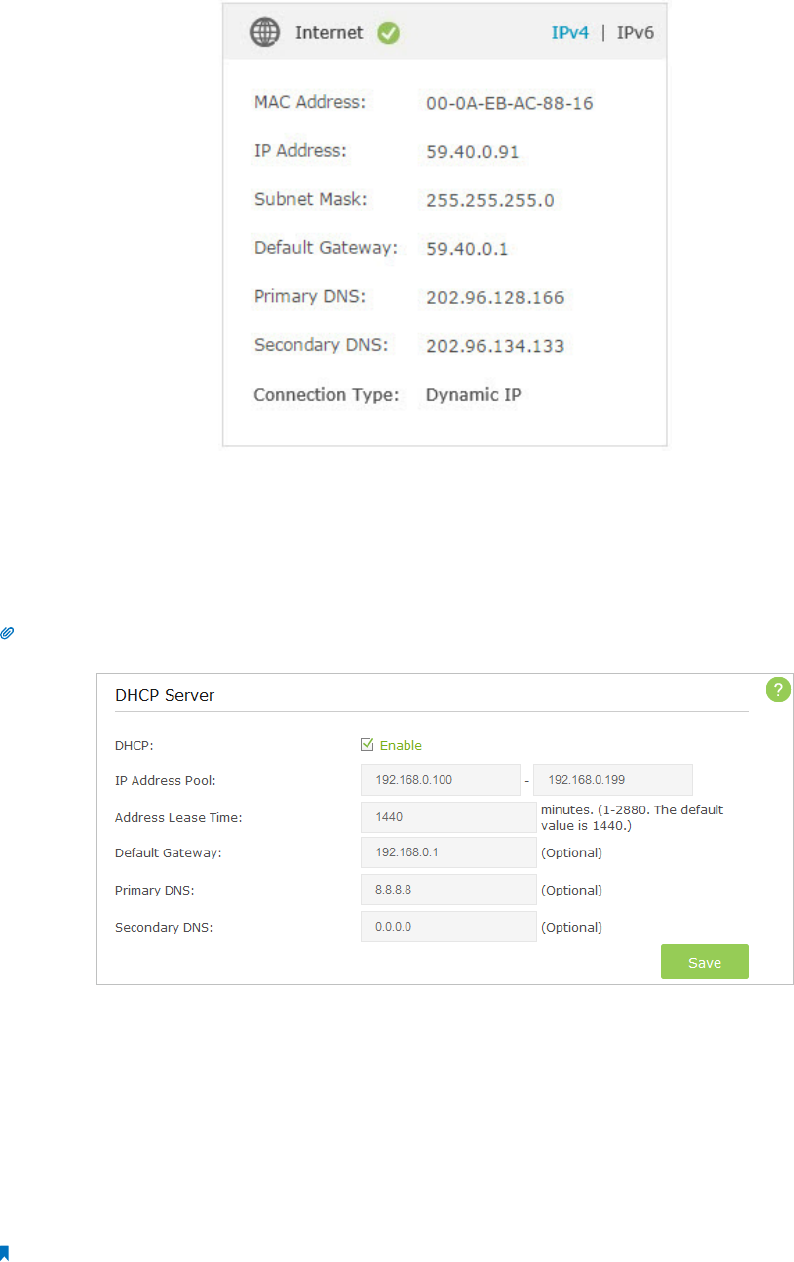
103
1. Your computer might not recognize any DNS server addresses, please manually configure DNS
server.
1 ) Go to Advanced > Network > DHCP Server;
2 ) Enter 8.8.8.8 as Primary DNS, click Save.
Tips: 8.8.8.8 is a safe and public DNS server operated by Google.
2. Power cycle the modem and the TP-LINK router.
1 ) Power off your modem and TP-LINK router, leave them off for 1 minute;
2 ) Power on your modem first, wait about 2 minutes until it get a solid cable or Internet light;
3 ) Power back TP-LINK router;
4 ) Wait another 1 or 2 minutes and check the Internet access.
3. Reset the router to factory default settings and reconfigure.
Note: You’ll have to reconfigure the router to access the Internet once the router is reset.
1 ) Reset the router to factory default settings: press and hold the RESET button for about 7
seconds and then release;
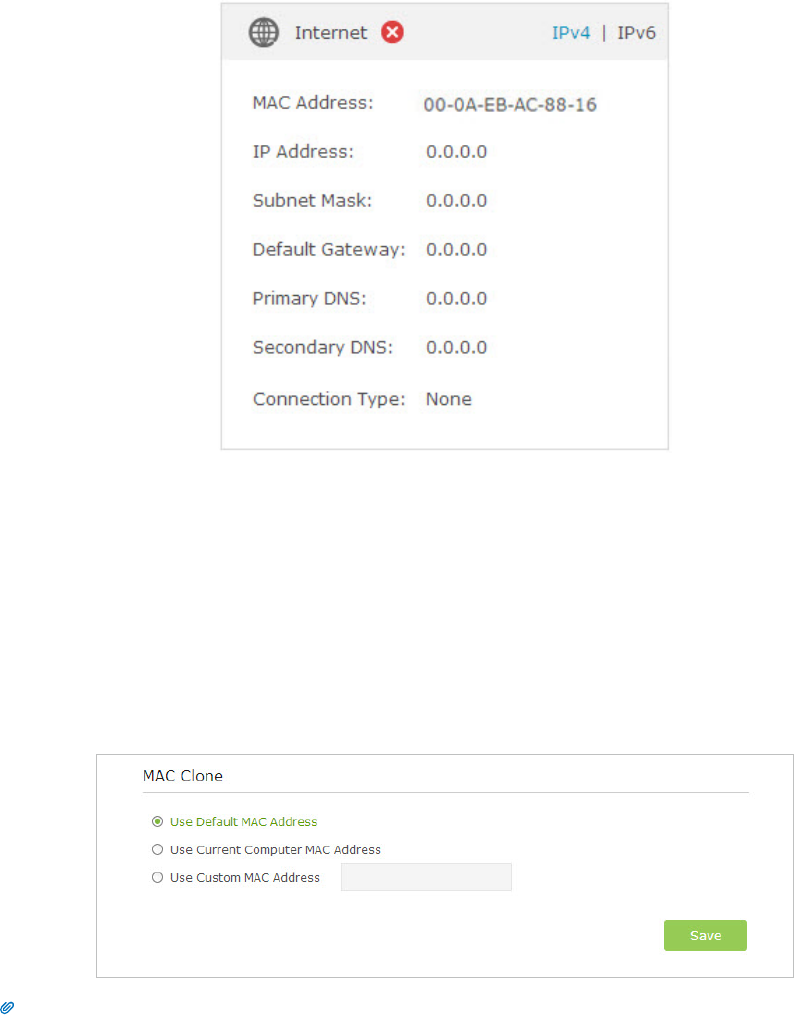
104
2 ) Reconfigure the router with the help of Quick Setup.
4. Please refer to Upgrade the Firmware to upgrade the firmware of the router.
¾If the IP Address is 0.0.0.0, please try the methods below and try again:
1. Check the physical connection.
Make sure the physical connection between the router and the modem is proper.
2. Clone the MAC address of your computer.
1 ) Visit http://tplinkwifi.net, and log in with the username and password you set for the router;
2 ) Go to Advanced > Network > Internet;
3 ) Choose an option to your need (Enter the MAC address if Use Custom MAC Address is
selected), and click Save.
Tips:
• Some ISP will register the MAC address of your computer when you access the Internet for the first time through their Cable
modem, if you add a router into your network to share your Internet connection, the ISP will not accept it as the MAC address is
changed, so we need to clone your computer’s MAC address to the router.
• The MAC addresses of a computer in wired connection and wireless connection are different.
3. Modify the LAN IP address of the router.
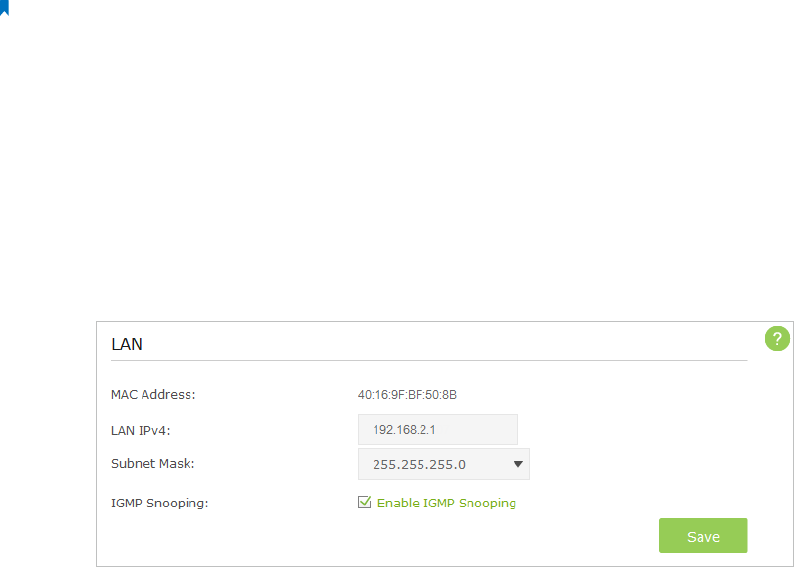
105
Note:
Most TP-LINK routers use 192.168.0.1/192.168.1.1 as their default LAN IP address, it may be conflicting with the IP range of your existent
ADSL modem/router. If so, the router is not able to communicate with your modem and cause you can’t access the Internet. To resolve
the problem, we need to change the LAN IP address of the router to avoid such conflict, for example, 192.168.2.1.
1 ) Visit http://tplinkwifi.net, and log in with the username and password you set for the router;
2 ) Go to Advanced > Network > LAN;
3 ) Modify the LAN IP address as the follow picture shows. Here we take 192.168.2.1 as an
example;
4 ) Click Save.
4. Power cycle the modem and the TP-LINK router.
1 ) Power off your modem and TP-LINK router, leave them off for 1 minute;
2 ) Power on your modem first, wait about 2 minutes until it get a solid cable or Internet light;
3 ) Power back TP-LINK router;
4 ) Wait another 1 or 2 minutes and check the Internet access.
5. Double check the Internet Connection Type.
1 ) Confirm your Internet Connection Type, which can be learned from the ISP;
2 ) Visit http://tplinkwifi.net, and log in with the username and password you set for the router;
3 ) Go to Advanced > Network > Internet;
4 ) Select your Internet Connection Type and fill in other parameters with the help of page
tips;
5 ) Click Save.
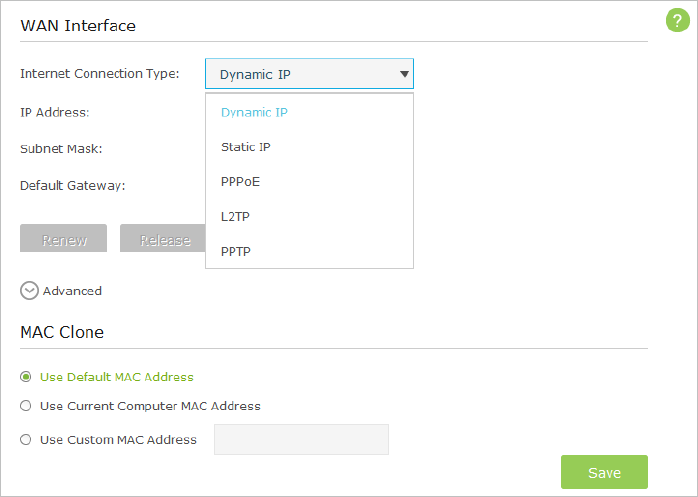
106
6 ) Power cycle the modem and the TP-LINK router again.
3. Please refer to Upgrade the Firmware to upgrade the firmware of the router.
4. Check the TCP/IP settings on the particular device if all other devices can get Internet from the
router.
If you’ve tried every method above but cannot access the Internet, please contact the technical
support.
Q5. I cannot find my wireless network or I cannot connect the wireless network,
what can I do?
¾If you fail to find any wireless network, please follow the steps below:
1. Make sure the wireless function is enabled if you’re using a laptop with built-in wireless adapter.
You can refer to the relevant document or contact the laptop manufacturer.
2. Make sure the wireless adapter driver is installed successfully and the wireless adapter is enabled.
On Windows 7
1 ) If you see the message No connections are available, it is usually because the wireless
function is disabled or blocked somehow;
2 ) Clicking on Troubleshoot and windows might be able to fix the problem by itself.
On Windows XP
1 ) If you see the message Windows cannot configure this wireless connection, this is usually
because windows configuration utility is disabled or you are running another wireless
configuration tool to connect the wireless;
2 ) Exit the wireless configuration tool( the TP-LINK Utility, for example);
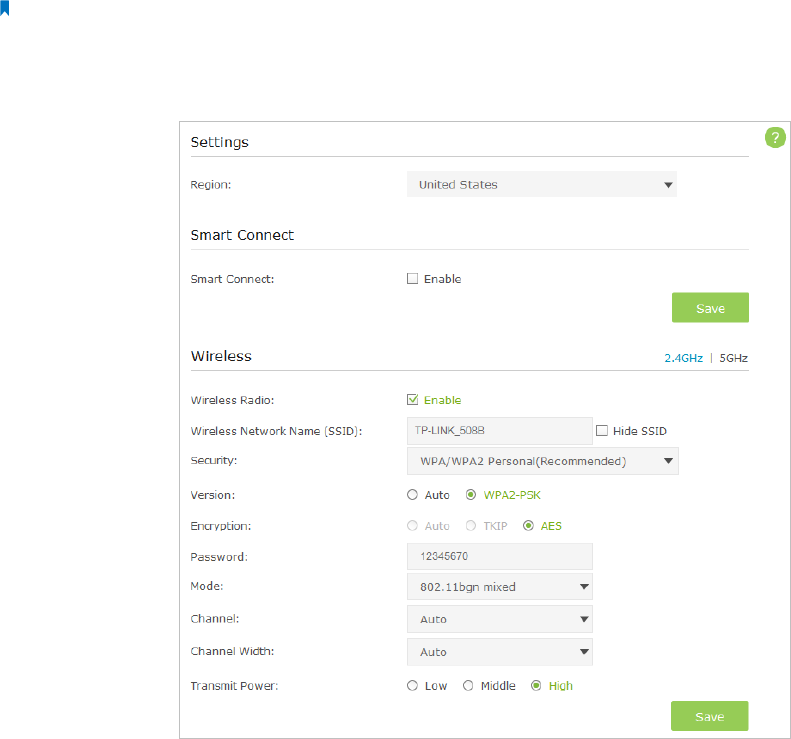
107
3 ) Select and right click on My Computer on desktop, select Manage to open Computer
Management window;
4 ) Expand Services and Applications > Services, find and locate Wireless Zero Configuration
in the Services list on the right side;
5 ) Right click Wireless Zero Configuration, and then select Properties;
6 ) Change Startup type to Automatic, click on Start button and make sure the Service status
is Started. And then click OK.
7 ) Connect to wireless network.
¾If you can find other wireless network except your own, please follow the steps below:
1. Check the wireless LEDs on your wireless router/modem;
2. Make sure your computer/device is still in the range of your router/modem, move closer if it is
currently too far away;
3. Go to Advanced > Wireless > Wireless Settings, and check the wireless router settings, double
check your Wireless Network Name, make sure the Region is selected correctly and wireless is
not hided;
Note:
Different countries have different laws about wireless channel. For example, USA allows 2.4GHz channel from 1 to 11, while UK
allows from 1 to 13. If you select the Region as UK or the Channel as 12/13 while you are in USA, your computer might not be able
to pick up the signal.
4. Connect to wireless network.
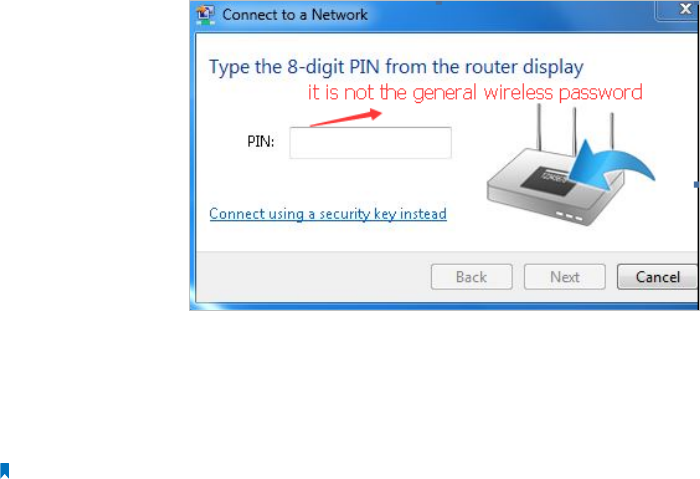
108
¾If you can find your wireless network but fail to connect, please follow the steps below:
• Authenticating problem, password mismatch:
1. Sometimes it will ask you to type in a PIN number when you connect to the wireless network
for the first time. This PIN number is different from the Wireless Password/Network Security Key,
usually you can only find it on the back of your wireless router;
2. If you cannot find the PIN or PIN failed, you may choose Connecting using a security key instead,
and then type in the Wireless Password/Network Security Key;
3. If it continues on saying Network Security Key Mismatch, it is suggested to confirm the wireless
password of your wireless router;
Note: Wireless Password/Network Security Key is case sensitive.
4. Connect to wireless network.
• Windows was unable to connect to XXXX /Can not join this network/Taking longer than usual to
connect to this network:
1. Check the wireless signal strength of your network, if it is weak (1~3 bars), please move the
router closer and try again;
2. Change the wireless Channel of the router to 1,6,or 11 to reduce interference from other networks;
3. Re-install or update the driver for your wireless adapter of the computer;
4. Connect to wireless network.
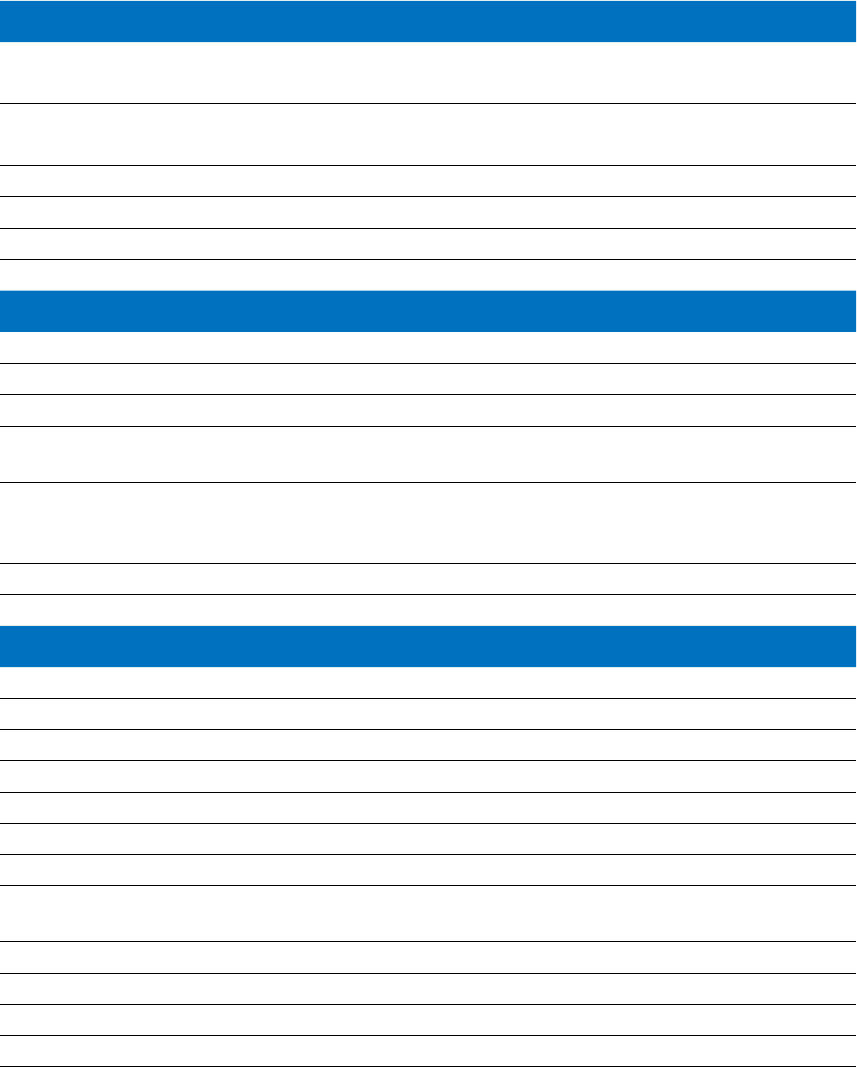
109
Specifications
Hardware
Ethernet Ports 4 10/100/1000Mbps LAN Ports
1 10/100/1000Mbps WAN Port
USB Port 1 USB 3.0 Ports
1 USB 2.0 Ports
Button WPS Button, Reset Button, Wireless On/Off Button, LED On/Off Button, Power On/Off Button
External Power Supply 12V/5A
Dimensions (W x D x H) 10.4×7.8×1.5 in. (263.8×197.8×37.3mm)
Antenna Four external antennas (RF-SMA-F). 2.4G gain: 2 dBi / 5G gain: 3dBi.
Wireless
Wireless Standards IEEE 802.11ac/n/a 5GHz, IEEE 802.11ac/n/g/b 2.4GHz
Frequency 2.4GHz, 5GHz
Signal Rate 2166Mbps at 5GHz, 1000Mbps at 2.4GHz
Transmit Power CE: <20dBm(2.4GHz), <23dBm(5GHz)
FCC: <30dBm
Reception Sensitivity
5GHz: 11a 6Mbps: -91dBm; 11a 54Mbps: -73dBm; 11n HT20: -70dBm; 11n HT40: -69dBm;
11ac HT20: -66dBm; 11ac HT40: -61dBm; 11ac HT80: -58dBm
2.4GHz: 11g 54Mbps: -76dBm; 11n HT20: -73dBm; 11n HT40: -71dBm
Wireless Function Enable/Disable Wireless Radio, WDS Bridge, WMM, Wireless Statistics
Wireless Security 64/128-bit WEP, WPA/WPA2, WPA-PSK/WPA-PSK2 encryptions
Software
WAN Type Dynamic IP/Static IP/PPPoE/PPTP(Dual Access)/L2TP(Dual Access)
DHCP Server, Client, DHCP Client List, Address Reservation
Quality of Service WMM, Bandwidth Control
Port Forwarding Virtual Server, Port Triggering, UPnP, DMZ
Dynamic DNS DynDns, NO-IP
VPN Pass-Through PPTP, L2TP, IPSec
VPN Server Open VPN, PPTP VPN
Access Control Parental Control, Local Management Control, Host list, Access
Schedule, Rule Management
Firewall Security DoS, SPI Firewall, IP Address Filter/Domain Filter, IP and MAC Address Binding
Protocols Supports IPv4 and IPv6
USB Sharing Supports Samba(Storage)/FTP Server/Media Server/Printer Server
Management Access Control, Local Management, Remote Management
Guest Network 2.4GHz guest network x 1, 5GHz guest network x 1

110
Environment
Operating Temperature 0℃~40℃ (32℉ ~104℉)
Storage Temperature -40℃~70℃ (-40℉ ~158℉)
Operating Humidity 10%~90% non-condensing
Storage Humidity 5%~90% non-condensing

111
COPYRIGHT & TRADEMARKS
Specifications are subject to change without notice. is a registered
trademark of TP-LINK TECHNOLOGIES CO., LTD. Other brands and product names are
trademarks or registered trademarks of their respective holders.
No part of the specifications may be reproduced in any form or by any means or
used to make any derivative such as translation, transformation, or adaptation
without permission from TP-LINK TECHNOLOGIES CO., LTD. Copyright © 2015 TP-LINK
TECHNOLOGIES CO., LTD. All rights reserved.

112
FCC STATEMENT
This equipment has been tested and found to comply with the limits for a Class B
digital device, pursuant to part 15 of the FCC Rules. These limits are designed to provide
reasonable protection against harmful interference in a residential installation. This
equipment generates, uses and can radiate radio frequency energy and, if not installed
and used in accordance with the instructions, may cause harmful interference to radio
communications. However, there is no guarantee that interference will not occur in a
particular installation. If this equipment does cause harmful interference to radio or
television reception, which can be determined by turning the equipment off and on,
the user is encouraged to try to correct the interference by one or more of the following
measures:
• Reorient or relocate the receiving antenna.
• Increase the separation between the equipment and receiver.
• Connect the equipment into an outlet on a circuit different from that to which
the receiver is connected.
• Consult the dealer or an experienced radio/ TV technician for help.
This device complies with part 15 of the FCC Rules. Operation is subject to the following
two conditions:
1 ) This device may not cause harmful interference.
2 ) This device must accept any interference received, including interference that
may cause undesired operation.
Any changes or modifications not expressly approved by the party responsible for
compliance could void the user’s authority to operate the equipment.
Note: The manufacturer is not responsible for any radio or TV interference caused by
unauthorized modifications to this equipment. Such modifications could void the
user’s authority to operate the equipment.
For product available in the USA/Canada market, only channel 1~11 can be operated.
Selection of other channels is not possible.
FCC RF Radiation Exposure Statement
This equipment complies with FCC RF radiation exposure limits set forth for an
uncontrolled environment. This device and its antenna must not be co-located or
operating in conjunction with any other antenna or transmitter.
“To comply with FCC RF exposure compliance requirements, this grant is applicable to
only Mobile Configurations. The antennas used for this transmitter must be installed to
provide a separation distance of at least 20 cm from all persons and must not be co-
located or operating in conjunction with any other antenna or transmitter.”

113
This device is restricted for indoor use.
CE Mark Warning
This is a class B product. In a domestic environment, this product may cause radio
interference, in which case the user may be required to take adequate measures.
RF Exposure Information
This device meets the EU requirements (1999/519/EC) on the limitation of exposure of
the general public to electromagnetic fields by way of health protection.
The device complies with RF specifications when the device used at 20 cm from your
body.
National Restrictions
This device is intended for home and office use in all EU countries (and other countries
following the EU directive 1999/5/EC) without any limitation except for the countries
mentioned below:
Country Restriction Reason/remark
Belarus Not implemented
Norway Implemented This subsection does not apply for the geographical area within a
radius of 20 km from the centre of Ny-Ålesund on Svalbard.
Italy Implemented This subsection does not apply for the geographical area within a
radius of 20 km from the centre of Ny-Ålesund on Svalbard.
Russian Federation Limited
implementation
1. SRD with FHSS modulation
1.1. Maximum 2.5 mW e.i.r.p.
1.2. Maximum 100 mW e.i.r.p. Permitted for use SRD for outdoor
applications without restriction on installation height only for purposes
of gathering telemetry information for automated monitoring
and resources accounting systems. Permitted to use SRD for other
purposes for outdoor applications only when the installation height is
not exceeding 10 m above the ground surface.
1.3.Maximum 100 mW e.i.r.p. Indoor applications.
2. SRD with DSSS and other than FHSS wideband modulation
2.1. Maximum mean e.i.r.p. density is 2 mW/MHz. Maximum 100 mW
e.i.r.p.
2.2. Maximum mean e.i.r.p. density is 20 mW/MHz. Maximum 100
mW e.i.r.p. It is permitted to use SRD for outdoor applications only
for purposes of gathering telemetry information for automated
monitoring and resources accounting systems or security systems.
2.3. Maximum mean e.i.r.p. density is 10 mW/MHz. Maximum 100 mW
e.i.r.p. Indoor applications.
Ukraine Limited
implementation
e.i.r.p. ≤100 mW with built-in antenna with amplification factor up to
6 dBi.
ATTENTION: Due to EU law, the country settings must be identical to the country where
the device is operating (important due to non-harmonised frequencies in the EU).
114
Restricted for indoor use.
Canadian Compliance Statement
This device complies with Industry Canada license-exempt RSS standard(s). Operation
is subject to the following two conditions:
1 ) This device may not cause interference, and
2 ) This device must accept any interference, including interference that may
cause undesired operation of the device.
Le présent appareil est conforme aux CNR d’Industrie Canada applicables aux appareils
radio exempts de licence. L’exploitation est autorisée aux deux conditions suivantes :
1 ) l’appareil ne doit pas produire de brouillage;
2 ) l’utilisateur de l’appareil doit accepter tout brouillage radioélectrique subi,
meme si le brouillage est susceptible d’en compromettre le fonctionnement.
This radio transmitter (IC: 8853A-C3150/ Model: Archer C3150) has been approved by
Industry Canada to operate with the antenna types listed below with the maximum
permissible gain indicated. Antenna types not included in this list (Specifications),
having a gain greater than the maximum gain indicated for that type, are strictly
prohibited for use with this device.
Le présent émetteur radio (IC: 8853A-C3150/ Model: Archer C3150) a été approuvé
par Industrie Canada pour fonctionner avec les types d’antenne énumérés ci-dessous
et ayant un gain admissible maximal. Les types d’antenne non inclus dans cette liste
(Specifications), et dont le gain est supérieur au gain maximal indiqué, sont strictement
interdits pour l’exploitation de l’émetteur.
Caution:
1 ) The device for operation in the band 5150–5250 MHz is only for indoor use
to reduce the potential for harmful interference to co-channel mobile satellite
systems;
2 ) For devices with detachable antenna(s), the maximum antenna gain permitted
for devices in the band 5725-5850 MHz shall be such that the equipment still
complies with the e.i.r.p. limits specified for point-to-point and non-point-to-
point operation as appropriate; and
The high-power radars are allocated as primary users (i.e. priority users) of the bands
5250-5350 MHz and 5650-5850 MHz and that these radars could cause interference
and/or damage to LE-LAN devices.
Radiation Exposure Statement:
This equipment complies with IC radiation exposure limits set forth for an uncontrolled
environment. This equipment should be installed and operated with minimum distance
20cm between the radiator & your body.
115
Déclaration d’exposition aux radiations:
Cet équipement est conforme aux limites d’exposition aux rayonnements IC établies
pour un environnement non contrôlé. Cet équipement doit être installé et utilisé avec
un minimum de 20 cm de distance entre la source de rayonnement et votre corps.
Industry Canada Statement
CAN ICES-3 (B)/NMB-3(B)
NCC Notice:
注意!
依據 低功率電波輻射性電機管理辦法
第十二條 經型式認證合格之低功率射頻電機,非經許可,公司、商號或使用者均
不得擅自變更頻率、加大功率或變更原設計之特性或功能。
第十四條 低功率射頻電機之使用不得影響飛航安全及干擾合法通行;經發現有干
擾現象時,應立即停用,並改善至無干擾時方得繼續使用。前項合法通信,指依
電信規定作業之無線電信。低功率射頻電機需忍受合法通信或工業、科學以及醫
療用電波輻射性電機設備之干擾。
減少電磁波影響,請妥適使用。

116
BSMI Notice:
安全諮詢及注意事項
• 請使用原裝電源供應器或只能按照本產品注明的電源類型使用本產品。
• 清潔本產品之前請先拔掉電源線。請勿使用液體、噴霧清潔劑或濕布進行
清潔。
• 注意防潮,請勿將水或其他液體潑灑到本產品上。
• 插槽與開口供通風使用,以確保本產品的操作可靠並防止過熱,請勿堵塞
或覆蓋開口。
• 請勿將本產品置放於靠近熱源的地方。除非有正常的通風,否則不可放在
密閉位置中。
• 請不要私自打開機殼,不要嘗試自行維修本產品,請由授權的專業人士進
行此項工作。
Korea Warning Statements:
당해 무선설비는 운용중 전파혼신 가능성이 있음.
Продукт сертифіковано згідно с правилами системи УкрСЕПРО на відповідність
вимогам нормативних документів та вимогам, що передбачені чинними
законодавчими актами України.
Safety Information
• When product has power button, the power button is one of the way to shut off the
product; when there is no power button, the only way to completely shut off power
is to disconnect the product or the power adapter from the power source.
• Don’t disassemble the product, or make repairs yourself. You run the risk of electric
shock and voiding the limited warranty. If you need service, please contact us.
• Avoid water and wet locations.
• Adapter shall be installed near the equipment and shall be easily accessible.
• The plug considered as disconnect device of adapter.
• CAUTION: RISK OF EXPLOSION IF BATTERY IS REPLACED BY AN INCORRECT TYPE.
DISPOSE OF USED BATTERIES ACCORDING TO THE INSTRUCTIONS.
• Use only power supplies which are provided by manufacturer and in the
original packing of this product.

117
• Alert to service person
CAUTION
DOUBLE POLE / NEUTRAL FUSING
This product can be used in the following countries:
AT BG BY CA CZ DE DK EE
ES FI FR GB GR HU IE IT
LT LV MT NL NO PL PT RO
RU SE SG SK TR UA US

TP-LINK TECHNOLOGIES CO., LTD
DECLARATION OF CONFORMITY
For the following equipment:
Product Description: AC3150 Wireless Dual Band Gigabit Router
Model No.: Archer C3150
Trademark: TP-LINK
We declare under our own responsibility that the above products satisfy all the technical regulations
applicable to the product within the scope of Council Directives:
Directives 1999/5/EC, Directives 2004/108/EC, Directives 2006/95/EC, Directives 1999/519/EC,
Directives 2011/65/EU
The above product is in conformity with the following standards or other normative documents
EN 300 328 V1.9.1
EN 301 489-1 V1.9.2 & EN 301 489-17 V2.2.1
EN 55022: 2010 + AC: 2011
EN 55024: 2010
EN 60950-1: 2006 + A11: 2009 + A1: 2010 + A12: 2011 + A2: 2013
EN 50385: 2002
EN 301 893 V1.8.1
EN50581: 2012
The product carries the CE Mark:
Person responsible for making this declaration:
Yang Hongliang
Product Manager of International Business Date of issue: 2015/11/12
TP-LINK TECHNOLOGIES CO., LTD
Building 24 (floors 1, 3, 4, 5), and 28 (floors 1-4) Central Science
and Technology Park, Shennan Rd, Nanshan, Shenzhen, China